Characterization of P2P IPTV Traffic Scaling Analysis
- 格式:pdf
- 大小:276.03 KB
- 文档页数:27
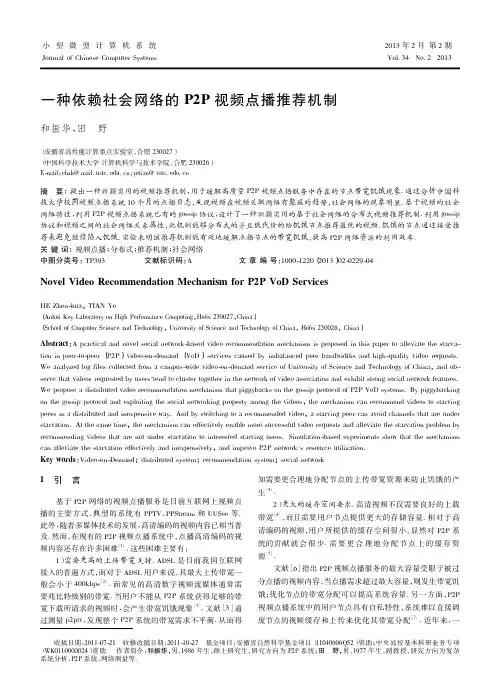
小型微型计算机系统Journal of Chinese Computer Systems 2013年2月第2期Vol.34No.22013收稿日期:2011-07-21收修改稿日期:2011-10-27基金项目:安徽省自然科学基金项目(11040606Q52)资助;中央高校基本科研业务专项(WK0110000024)资助.作者简介:和振华,男,1986年生,硕士研究生,研究方向为P2P 系统;田野,男,1977年生,副教授,研究方向为复杂系统分析、P2P 系统、网络测量等.一种依赖社会网络的P2P 视频点播推荐机制和振华,田野(安徽省高性能计算重点实验室,合肥230027)(中国科学技术大学计算机科学与技术学院,合肥230026)E-mail :ehzh@mail.ustc.edu.cn ;yetian@vstc.edo.cn摘要:提出一种新颖实用的视频推荐机制,用于缓解高质量P2P 视频点播服务中存在的节点带宽饥饿现象.通过分析中国科技大学校园视频点播系统10个月的点播日志,发现视频在视频关联网络有聚簇的趋势,社会网络的现象明显.基于视频的社会网络特性,利用P2P 视频点播系统已有的gossip 协议,设计了一种新颖实用的基于社会网络的分布式视频推荐机制.利用gossip 协议和视频之间的社会网络关系属性,此机制能够分布式的并且低代价的给饥饿节点推荐最优的视频.饥饿的节点通过接受推荐来避免继续陷入饥饿.实验表明该推荐机制能有效地缓解点播节点的带宽饥饿,提高P2P 网络资源的利用效率.关键词:视频点播;分布式;推荐机制;社会网络中图分类号:TP393文献标识码:A文章编号:1000-1220(2013)02-0229-04Novel Video Recommendation Mechanism for P2P VoD ServicesHE Zhen-hua ,TIAN Ye(Anhui Key Laboratory on High Performance Compoting ,Hefei 230027,China )(School of Computer Science and Technology ,University of Science and Technology of China ,Hefei 230026,China )Abstract :A practical and novel social network-based video recommendation mechanism is proposed in this paper to alleviate the starva-tion in peer-to-peer (P2P )video-on-demand (VoD )services caused by imbalanced peer bandwidths and high-quality video requests.We analyzed log files collected from a campus-wide video-on-demand service of University of Science and Technology of China ,and ob-serve that videos requested by users'tend to cluster together in the network of video association and exhibit strong social network features.We propose a distributed video recommendation mechanism that piggybacks on the gossip protocol of P2P VoD systems.By piggybacking on the gossip protocol and exploiting the social networking property among the videos ,the mechanism can recommend videos to starving peers in a distributed and inexpensive way.And by switching to a recommended video ,a starving peer can avoid channels that are under starvation.At the same time ,the mechanism can effectively enable more successful video requests and alleviate the starvation problem by recommending videos that are not under starvation to interested starving users.Simulation-based experiments show that the mechanism can alleviate the starvation effectively and inexpensively ,and improve P2P network's resource utilization.Key words :Video-on-Demand ;distributed system ;recommendation system ;social network1引言基于P2P 网络的视频点播服务是目前互联网上视频点播的主要方式,典型的系统有PPTV 、PPStream 和UUSee 等.此外,随着多媒体技术的发展,高清编码的视频内容已相当普及.然而,在现有的P2P 视频点播系统中,点播高清编码的视频内容还存在许多困难[1].这些困难主要有:1)需要更高的上传带宽支持.ADSL 是目前我国互联网接入的普遍方式,而对于ADSL 用户来说,其最大上传带宽一般会小于400kbps[2].而常见的高清数字视频流媒体通常需要兆比特级别的带宽.当用户不能从P2P 系统获得足够的带宽下载所请求的视频时,会产生带宽饥饿现象[3].文献[3]通过测量p2ptv ,发现整个P2P 系统的带宽需求不平衡.从而得知需要更合理地分配节点的上传带宽资源来防止饥饿的产生[4].2)更大的缓存空间要求.高清视频不仅需要良好的上载带宽[4],而且需要用户节点提供更大的存储容量.相对于高清编码的视频,用户所提供的缓存空间很小,显然对P2P 系统的贡献就会很少.需要更合理地分配节点上的缓存资源[5].文献[6]指出P2P 视频点播服务的最大容量受限于被过分点播的视频内容,当点播需求超过最大容量,则发生带宽饥饿;优化节点的带宽分配可以提高系统容量.另一方面,P2P 视频点播系统中的用户节点具有自私特性,系统难以直接调度节点的视频缓存和上传来优化其带宽分配[7].近年来,一些研究发现P2P系统中的用户行为具有很强的社会网络特性[8],利用用户的社会网络性,P2P系统的性能可以得到进一步优化.在我们的工作中,通过对中国科技大学校园视频点播系统[9]10个月点播日志实施数据挖掘,我们分析了用户在视频点播中的行为特性,并构建了一个视频关联图模型.借助视频关联图,我们发现在用户在视频请求中存在明显的社会网络特性[3].基于这一发现,本文设计了一个应用于P2P高质量视频点播服务的、基于社会网络的视频推荐机制.在视频推荐机制中:当某一节点在请求某一视频时,如果由于缓存和上传带宽资源的限制,用户不能获得足够下载带宽而产生饥饿现象,则用户通过分布式的推荐机制,获取当前资源充足且感兴趣的视频列表;用户通过转而请求推荐的视频内容以避免饥饿.仿真实验表明该推荐机制可以有效地缓解P2P视频点播中节点的饥饿现象,提高P2P视频点播系统中资源的利用率.2视频点播用户行为挖掘与分析我们对中国科技大学校园视频点播系统(USTC VoD)从2009年4月29日到2010年2月27日大约10个月的点播日志[11]实施数据挖掘与分析.USTC VoD采用Microsoft的Win-dows Media Services(WMS)作为点播服务平台.在WMS中,当用户请求一个视频,或进行一次VCR操作,比如快进、暂停或开始,系统都会产生日志信息.USTC VoD系统包含超过15,000个视频供校园网用户点播.USTC VoD系统包括2台点播服务器,包含不同视频内容:1)教育类视频,2)影视娱乐类视频.为了避免视频内容的干扰而更好的观察用户的行为,所以我们仅考虑用户对单个视频内容的点播行为,而不考虑有承接关系的视频,如电视连续剧等.我们共观察到5,819个用户对2,651个教育类视频的53,516次点播和5,957个用户对3,082个娱乐类视频的70,772次点播.2.1视频关联图模型和社会网络性对用户请求视频的行为进行建模,我们可以获得视频之间的关联程度.现引入有向权重图G=(V,E)命名为视频关联图模型.数据集中的每个视频对应关联图模型G上的一个节点.针对任意两个视频i,j,其对应到图模型上的节点定义为v i,v j.边e ij上的权重定义为ωij,ωij=既请求视频i又请求视频j的用户对i,j的请求次数请求视频i的用户对i的请求次数(1)对视频关联图模型G,我们有如下观察:观察1:对于USTC VoD数据集中的某一个用户,其请求视频的序列可以视为在关联图模型G上的一条游走路径.观察2:如果打乱某个用户的已知视频点播顺序,那么我们仍然可以在关联图模型G上找到一条游走路径,并且路径的节点顺序与对应的视频点播序列相同.基于以上观察,我们发现用户请求视频的序列可以看作是关联图模型G上的一条游走路径.假设视频之间没有承接关系(例如不包含电视剧集等视频内容),则可以把用户的点播行为描述为视频关联图模型G上的随机游走.我们关注的是关联图模型G中视频对应节点之间的关系.关联系数(Clustering coefficient)是在图论中用于描述图中节点之间聚簇程度的关键指标.由于本文定义的关联图模型G为一个有向权重图,因此采用Fagiolo[12]的定义来计算关联系数.关联图模型G上节点和图的关联系数定义如下:1)对节点vi,则它与它的邻居节点间能够形成有向三角形数目为:T Di=∑(aij+aji)·(∑j≠i(aij+aji)-1)-2∑j≠iaijaji(2)其中{a ij}为关联图模型G的矩阵描述.2)节点vi与它的邻居节点间实际形成的有向三角形的个数为:(^W+^W T)3ii=({w1/3ij}+{w1/3ji})3ii=∑i≠j∑h≠(i,j)[(w1/3ij+w1/3ji)(w1/3ih+w1/3hi)(w1/3jh+w1/3hj)](3)3)节点vi的关联系数为^C Di=(^W+^W T)3ii2T Di(4)4)包含N个节点的有向权重图的关联系数为C=∑^C D iN(5)利用USTC VoD数据集中用户对教育类视频和娱乐类视频这两类视频内容的点播行为构造视频关联图模型,并分析图的关联系数.对于每一类视频,我们利用USTC VoD数据集中用户对教育类视频和娱乐类视频这两类视频内容的点播行为构造视频关联图模型,并分析图的关联系数,如图1.对于每一类视频,我们分别构造了3个视频关联图模型,分别包含用户在1个月、2个月、3个月内的视频点播请求行为.图1视频关联图模型的关联系数Fig.1Clustering coefficient另外,针对每个关联图模型图,在节点个数、节点的平均度和有向边的平均权重系数不变的条件下,我们分别构造了有向权重随机图,并计算图的关联系数.图1显示了一、二和三个月以来,根据用户对两类视频的点播行为所构造的视频关联图模型,以及对应的有向权重随机图模型的关联系数.从图1中可以看出,视频关联图模型的关联系数远大于随机图模型,表明节点对应的视频随用户点播请求具有很强的关联趋势.此外,我们还发现:1)娱乐类视频的关联图关联系数大于教育类视频.这很可能是由于用户在娱乐上的兴趣影响比在科教方面要深刻.2)数据集的时间跨度越大,其关联系数值反而越小,也即节点开始趋于分散.032小型微型计算机系统2013年3P2P视频点播视频推荐机制设计由于点播节点在上载带宽以及存储上的不均衡性,导致现有的P2P系统对高清视频支持能力有限,当点播节点不能够从P2P系统中获得足够带宽时,即产生带宽饥饿.基于此,我们提出了一种分布式的基于社会网络的视频推荐机制,旨在最大化地利用P2P系统的带宽和存储资源,避免点播节点饥饿.我们的主要思路是,当用户点播某一视频资源时,如果产生带宽饥饿,则系统根据用户此时的点播请求内容推荐给用户若干视频资源.而推选的资源应该满足以下两个条件:1)符合用户当前的兴趣;2)此资源在P2P系统中有丰富的缓存和下载带宽.3.1推荐机制设计我们的分布式推荐机制由节点上的推荐模块组成,介绍如下:1)处理视频请求历史在包含推荐机制的P2P点播系统中,每个节点都会保存自己的视频请求信息.一个节点的请求历史假设保存在一个长度为L的FIFO队列中.用户每成功点播一个视频,相应的视频条目就会追加到队列中.对某个节点x,它的历史队列记为h x.我们利用P2P流媒体系统中广泛使用的gossip协议[13]来交换和共享节点间的视频请求历史信息,并获取推荐信息.在gossip协议中,节点周期性地与它的邻居节点交换gossip 报文,包含如节点上本地缓存的视频块信息、节点的邻居信息等.通过gossip协议,节点可以有效地定位所请求视频的资源节点.对于节点x,定义它的邻居节点集合为N x.当节点x在观看视频i时,其通过gossip发现它的邻居节点y,此时,两节点交换它们的历史队列h x和h y.通过与所有邻居节点交换gossip报文,节点x获得了其邻居节点的点播请求历史记录集合,记为H x={h y}y∈Nx.当节点请求视频i 时,如果不能从P2P视频点播系统获得足够的带宽下载视频内容,则x发生饥饿,此时节点上的推荐模块启动,通过查询邻居节点点播历史集合H x来定位一系列用户可能感兴趣的视频,并且确保获得推荐的视频在当前P2P点播系统中有充足的资源可供节点x下载.推荐模块工作流程如下:a)获取候选视频集合:首先初始化候选视频集合C,以视频i为关键字遍历其邻居节点的点播请求历史记录集合H x={hy }y∈N x,若视频i不等于视频j,并且视频i与视频j均在点播请求历史记录集合H x中,则将视频j添加到候选视频集合C中.至此,完成候选视频集合获取;b)对候选集合评分:遍历整个候选视频集合C,并对集合内的每个视频利用2)部分的评分策略进行评分;c)形成推荐列表R:根据评分值对候选视频集合C中的元素进行排序,并选出k前项,然后推送给处于饥饿中的节点.2)评分策略在上述视频推荐过程中,对每个候选视频,我们计算一个分值,用于表示节点x对候选视频感兴趣的程度.我们考虑3种计算方法:基于距离的评分策略、基于相似度的评分策略、基于距离和相似度的混合评分策略.a)基于点播请求距离S(c,i)=∑h y:i∈h ye-dis(h y:i,c)(6)距离dis(h y:i,c)在这里表示在包含自对视频i的请求的历史记录h y中,从请求视频i完到请求视频c之间的视频点播请求条目个数.b)基于节点相似度S(c,i)=∑h y:i∈h ysim(x,y)(7)在这里,sim(x,y)表示节点x与节点y请求历史的相似度.对于相似度,可以通过计算节点x与节点y请求历史记录的皮尔森相关系数(Pearson correlation)或者余弦相似度获得.c)混合评分策略S(c,i)=∑h y:i∈h ysim(x,y)ˑe-dis(h y:i,c)(8)这里对每一个候选视频c,我们综合节点相似度和视频点播请求距离计算候选视频的分值.4仿真实验与性能分析为了检验推荐机制的有效性,本文进行了仿真实验.在实验中,我们使用教育类数据集来模拟用户请求行为.首先,根据视频的流行度随机的给用户初始化一个请求视频,然后在关联图模型G上以节点关联系数的概率随机游走,以此模拟用户的点播行为.也即,当用户观看完一个视频后,他会随机地以当前节点关联系数的概率去请求下一个视频.假设所有的视频都是同样的编码率,当用户请求某一视频时,所有的节点和服务器均尽最大努力提供上载带宽.然而当用户请求不到足够的带宽时,此时,节点被认为是处于饥饿状态.此时如有推荐机制,用户就可以以一定的概率请求推荐的视频.所以,我们考虑以下实验方法:1)没推荐机制:整个P2P系统中不提供任何推荐机制.2)随机推荐机制:在随机推荐策略中,当用户请求失败后,随机从系统中选取部分视频作为推荐视频列表.3)基于社会网络的分布式推荐机制:在仿真系统中,我们选用基于距离和相似度的混合评分策略作为推荐机制的评分策略,以此为依据产生推荐视频列表.4)理想系统:在这个理想策略中,我们假设整个P2P视频点播系统拥有关联图模型G的全局信息.并且当用户请求失败后,理想系统优先推荐给用户评分最高的视频.显然,这只是理想系统,在分布式环境中没有太大的实用价值,但是我们可以把它当作参照对象,来检验基于社会网络推荐机制的有效性.在仿真系统中,当用户获得推荐视频列表后,我们通过全局的视频关联图模型判断用户是否对推荐的视频感兴趣.当用户不能从推荐列表中获得感兴趣的视频,则该用户的点播请求失败;而无论用户成功点播其初始选择的视频或者任意推荐视频,我们认为该用户的点播请求成功.我们通过计算不同P2P视频点播系统下点播请求成功的次数来衡量推荐机制的性能.我们在仿真系统中模拟10,000个用户节点,并对用户节点的下载带宽不做限制.视频服务器的上载带宽被设定为1322期和振华等:一种依赖社会网络的P2P视频点播推荐机制(视频数量+1000)ˑ视频编码率.图2显示了不同策略的对比情况.从图2可以看到在随机推荐机制下,系统中用户节点的成功请求次数仅略高于无推荐的P2P点播系统.然而,对比随图2不同策略下请求成功数量Fig.2Number of successful requests with different policy机推荐机制和基于社会网络的分布式推荐机制,可以看出基于社会网络的推荐机制通过分布式的视频推荐机制,有效地利用了P2P网络的带宽和存储资源,提高了视频点播请求的成功率.表1推荐的质量和数量Table1Quality and quantity of recommendations平均边权重接受推荐次数随机推荐机制0.0031847,168理想系统0.014718105,048基于社会网络的推荐机制0.00701357,710同时,我们还关注推荐机制的准确性和推荐视频的数量.表1列出了在三种推荐机制下,用户接受推荐视频的次数,以及所接受的推荐视频与用户初始选择视频在视频关联图模型G上对应的有向边的平均权重.从表1可以看出:1)理想系统推荐的视频之间具有较高的平均权重,这表明推荐的视频有较大可能被用户接受;2)与随机推荐相比,基于社会网络的推荐机制更能推荐平均权重较大的视频,因此,获得用户接受的概率比随机策略高.5结语在目前的P2P视频点播系统上向大量的用户提供高清的视频点播服务是一个很大的挑战.本文通过分析中国科学技术大校园视频系统的日志记录,发现视频之间随用户的点播行为呈现出很强的社会网络现象.基于视频的社会网络特性,利用P2P视频点播系统已有的gossip协议,我们设计了一种新颖实用的基于社会网络的分布式视频推荐机制.仿真实验表明,我们提出的基于社会网络的分布式推荐可以给用户推荐相似的资源,同时极大缓解了带宽饥饿现象的发生.同时,对比其他策略,得出社会网络推荐机制可以有效地改进高清P2P视频点播系统的性能.References:[1]Jiang J W,Chan S H G,et al.1mbps p2p streaming:a global meas-urement study[R].Princeton University,May,2010.[2]Huang C,Li J,et al.Can internet video-on-demand be profitable?[C].In Proc.of ACM Sigcomm'07,Kyoto,Japan,Aug,2007.[3]Alessandria E,Gallo M,et al.P2P-tv systems under adverse network conditions:a measurement study[C].In Proc.of IEEE INFOCOM' 09,Rio de Janeiro,Brazil,Apr,2009.[4]Mao Jun-peng,Cui Yan-li,Huang Jian-hua,et al.Study of resource s load model of P2P network[J].Journal of Chinese Computer Sys-tems,2010,31,(2):215-219.[5]Shen Shi-jun,Li San-li.Novasky:design and implementation of a re-al world VoD/P2P system[J].Journal of Chinese Computer Sys-tems,2011,32(6):1041-1048.[6]He Y,Guan L.Solving streaming capacity problems in P2P vod sys-tems[J].IEEE Transactions on Circuits and Systems for Video Tech-nology,2010,20(11):1638-1642.[7]Wu W,Lui J C S,Ma R T B.Incentivizing upload capacity in P2P-vod systems:a game theoretic analysis[C].In Proc.of GameNets' 11,2011.[8]Yu H,Zheng D,et al.Understanding user behavior in large scale video-on-demand systems[C].In Proceedings of the EuroSys'06,Leuven,Belgium,Apr,2006.[9]USTC Video City[EB/OL].http://video.ustc.edu.cn,Feb,2010.[10]Bao Yi-ping,Yao Li,Zhang Wei-ming,et al.Model for computing feedback trustworthiness by recommending behavior in P2P networks [J].Journal of Chinese Computer Systems,2010,31,(11):2191-2195.[11]USTC Video Log[EB/OL].www.nhpcc.ustc.edu.cn/P2P/VoDDa-ta/,Feb,2010.[12]Fagiolo G.Clustering in complex directed networks[J].Physical Reviewe,2007,76(2):026107.[13]Tian Y,Wu D.A novel caching mechanism for peer-to-peer based media-on-demand streaming[J].Journal of System Architecture,2008,54(1-2):55-69.附中文参考文献:[4]毛军鹏,崔艳莉,黄建华,等.P2P网络资源负载模型研究[J].小型微型计算机系统,2010,31,(2):215-219.[5]沈时军,李三立.一个真实VoD/P2P系统Novasky的设计与实现[J].小型微型计算机系统,2011,32,(6):1041-1048.[10]鲍翊平,姚莉,张维明,等.对等网中一种面向推荐行为的反馈可信度评估模型[J].小型微型计算机系统,2010,31,(11):2191-2195.232小型微型计算机系统2013年。
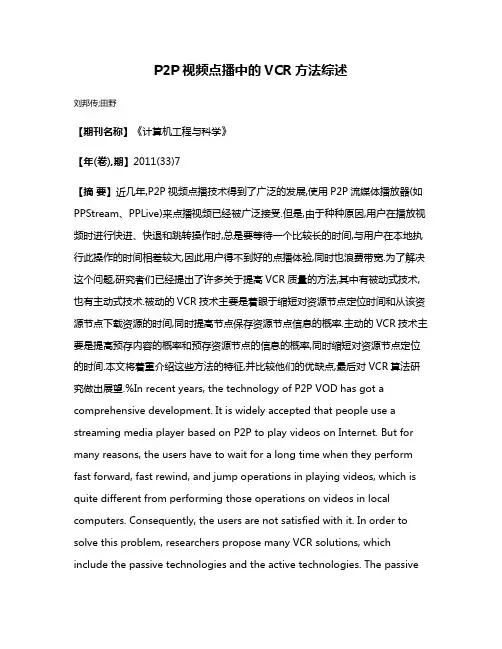
P2P视频点播中的VCR方法综述刘邦传;田野【期刊名称】《计算机工程与科学》【年(卷),期】2011(33)7【摘要】近几年,P2P视频点播技术得到了广泛的发展,使用P2P流媒体播放器(如PPStream、PPLive)来点播视频已经被广泛接受.但是,由于种种原因,用户在播放视频时进行快进、快退和跳转操作时,总是要等待一个比较长的时间,与用户在本地执行此操作的时间相差较大,因此用户得不到好的点播体验,同时也浪费带宽.为了解决这个问题,研究者们已经提出了许多关于提高VCR质量的方法,其中有被动式技术,也有主动式技术.被动的VCR技术主要是着眼于缩短对资源节点定位时间和从该资源节点下载资源的时间,同时提高节点保存资源节点信息的概率.主动的VCR技术主要是提高预存内容的概率和预存资源节点的信息的概率,同时缩短对资源节点定位的时间.本文将着重介绍这些方法的特征,并比较他们的优缺点,最后对VCR算法研究做出展望.%In recent years, the technology of P2P VOD has got a comprehensive development. It is widely accepted that people use a streaming media player based on P2P to play videos on Internet. But for many reasons, the users have to wait for a long time when they perform fast forward, fast rewind, and jump operations in playing videos, which is quite different from performing those operations on videos in local computers. Consequently, the users are not satisfied with it. In order to solve this problem, researchers propose many VCR solutions, which include the passive technologies and the active technologies. The passivetechnologies focus on reducing the time of locating the source node and downloading sources from it, at the same time, improve the possibility of saving the information of the source node. Active technologies focus on improving the possibility of the pre-saved content of video and the information of the source node. This paper plays emphasis on introducing the characteristics of these algorithms and comparing their merits and limitations. At the end, a view of the future development of VCR will be given in order to provide a reference to future study.【总页数】7页(P94-100)【作者】刘邦传;田野【作者单位】中国科学技术大学计算机科学与技术学院,安徽合肥230026;中国科学技术大学计算机科学与技术学院,安徽合肥230026【正文语种】中文【中图分类】TP393【相关文献】1.基于P2P技术的视频点播系统中的数据调度策略 [J], 额尔敦巴日斯;孙颖2.P2P技术在智能小区视频点播系统中的应用 [J], 薛颖;王玲;冷华3.基于P2P的视频点播系统在远程教育中的应用 [J], 刘琰4.基于P2P的视频点播系统综述 [J], 沈时军;李三立5.一种基于传输流的视频点播VCR功能实现方法 [J], 朱小勇;倪宏;孙鹏;姚琼因版权原因,仅展示原文概要,查看原文内容请购买。
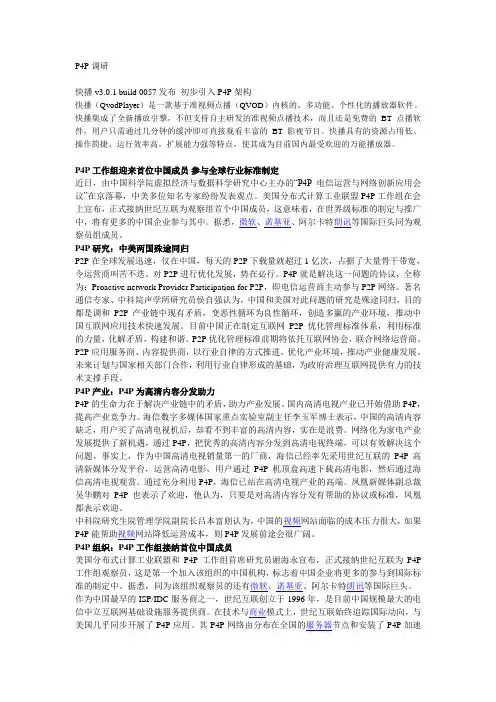
P4P调研快播v3.0.1 build 0057发布初步引入P4P架构快播(QvodPlayer)是一款基于准视频点播(QVOD)内核的、多功能、个性化的播放器软件。
快播集成了全新播放引擎,不但支持自主研发的准视频点播技术,而且还是免费的BT 点播软件,用户只需通过几分钟的缓冲即可直接观看丰富的BT 影视节目。
快播具有的资源占用低、操作简捷、运行效率高,扩展能力强等特点,使其成为目前国内最受欢迎的万能播放器。
P4P工作组迎来首位中国成员参与全球行业标准制定近日,由中国科学院虚拟经济与数据科学研究中心主办的―P4P电信运营与网络创新应用会议‖在京落幕,中美多位知名专家纷纷发表观点。
美国分布式计算工业联盟P4P工作组在会上宣布,正式接纳世纪互联为观察组首个中国成员,这意味着,在世界级标准的制定与推广中,将有更多的中国企业参与其中。
据悉,微软、诺基亚、阿尔卡特朗讯等国际巨头同为观察员组成员。
P4P研究:中美两国殊途同归P2P在全球发展迅速,仅在中国,每天的P2P下载量就超过1亿次,占据了大量骨干带宽,令运营商叫苦不迭。
对P2P进行优化发展,势在必行。
P4P就是解决这一问题的协议,全称为:Proactive network Provider Participation for P2P,即电信运营商主动参与P2P网络。
著名通信专家、中科院声学所研究员侯自强认为,中国和美国对此问题的研究是殊途同归,目的都是调和P2P产业链中现有矛盾,变恶性循环为良性循环,创造多赢的产业环境,推动中国互联网应用技术快速发展。
目前中国正在制定互联网P2P优化管理标准体系,利用标准的力量,化解矛盾,构建和谐。
P2P优化管理标准前期将依托互联网协会,联合网络运营商、P2P应用服务商、内容提供商,以行业自律的方式推进,优化产业环境,推动产业健康发展。
未来计划与国家相关部门合作,利用行业自律形成的基础,为政府治理互联网提供有力的技术支撑手段。
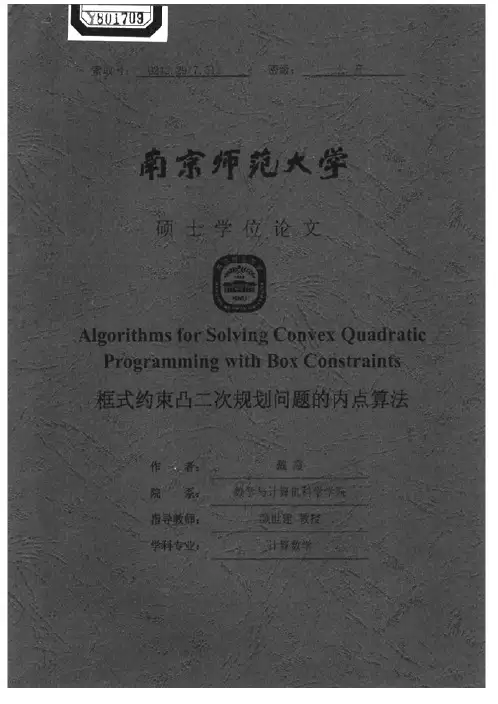
南京珂勉犬掌硕毒.学倪:论文懿鬻黼”一j、奠:蕊i嚣1簧≥!i二‘“.≥☆导毂目:e些敦瑶。
7,一5~。
≤二、二≥≤_?j≥;等等≥》,?,jj_j。
||jo。
孥?一。
,/j一?7.∥j爹一-。
|。
_≯。
篓??j≯≥。
0i、Ij;’j_框式约束凸二次规划问题的内点算法作者:戴霞学位授予单位:南京师范大学被引用次数:1次1.J C Dunn On the convergence of projected gradient porcesses to singular crit ical point 1987(55)2.Y Yuan Numerical Methods for Nonlinear Programming 19933.Z Q Luo.P Tseng ON the convergence of a matrix splitting algorithm for the symmetric monotone linear complementarity problem 1991(29)4.Z J Lu.Z L Wei Decomposition method for quadratic programming prob lem with box constraints 19995.Zi-Luan Wei Subspace search method for quadratic programming with box constraints[外文期刊]1999(18)6.Y Ye On an affine scaling algorithm for nonconvex quadratic programming 1992(52)7.Y Ye Interior Point Algorithms:Theory and Analysis 19978.A Friedlander.J M Martinez On the maximization of a concave quadratic func tion with box constraints 1994(04)9.G G Han.P M Pardalos.Y Ye Computational aspects of an interior point algorithm for quadratic programming problem with box constraints 199010.K M Anstreicher Potential reduction algorithms 199611.M J Todd Potential-reduction method in mathematical programming 1997(76)12.Y Yuan.W Sun Optimization Theory and Methods 199713.K M Anstreicher A combined phase Ⅰ-phase Ⅱ projective algorithm for linear programming1989(43)14.K M Anstreicher A combined phase Ⅰ-phase Ⅱ scale potential algorithm for linear programming 1991(52)15.R M Freund A potential-function reduction algorithm for solving a linear pro gramming directly from a infeasible warm start 1991(52)16.M J Todd On Anstreicher's combined phase Ⅰ-phase Ⅱ projective algorithm for linear programming 1992(55)17.M J Todd Combing phase Ⅰ-phase Ⅱ in a potential reduction algorithm for linear programming 1993(59)18.Kojima M.Noma T.Yoshise A Global Convergence in Infeasible interior-point Algorithms 199419.Mizuno S.Kojima M.Todd M J Infeasible interior-point Primal-dual Potential Reduction Algorithms for Linear Programming 199520.Zi-Luan Wei The Predictor-Correct Interior Point Method for Convex Quadratic Programming Problem with Box Constraints 1998(03)21.张明望.黄崇超框式凸二次规划问题的非精确不可行内点算法[期刊论文]-应用数学 2004(2)22.王浚岭.张明望一类框式凸规划的原始-对偶内点算法[期刊论文]-应用数学 2000(1)23.张艺框式约束凸二次规划问题的内点算法[期刊论文]-高等学校计算数学学报 2002(2)24.Zi-Luan Wei Regular SPlitting and Potential Reduction Method for Solving Quadratic Programming Problem with Box Constraints 2002(06)25.McCormick G P Nonlinear Programming:Theory,Algorithms and Appli cations 198326.Alizadeh F Interior point methods in semidefinitc programming with appli cation to combinatorial optimization 199527.Alizadeh F.Haeberly J P A.Overton M L Primal-dual interior point methods for semidefinite programming28.Fujisawa K.Kojima M.Nakata K Exploiting sparsity in primal-dual interior-point methods for semidefinite programming[外文期刊] 199729.Todd M J.Toh K C.Tütüncü R H On the Nesterov-Todd direction in semidefinite programming 199630.贺素香非线性规划问题的一个内点势减算法的全局收敛性[期刊论文]-浙江大学学报(理学版) 2004(3)31.Zhang Y On extending primal-dual interior-point algorithms from linear programming to semidefinite programming32.Zhao Q.Karische S E.Rendl F Semidefinite programming relax ations for the quadratic assignment problem 199633.Masakazu Kojima.Nimrod Megiddo.Yinyu Ye An interior point potential reduction algorithm for the linear complementarity problem 19891.于绍慧边界约束凸二次规划的求解[学位论文]20052.佟世璐.孟煦.荆湘霞.TONG Shi-lu.MENG Xu.JING Xiang-xia求解框式约束下凸二次规划问题的内点算法[期刊论文]-复旦学报(自然科学版)2000,39(1)3.徐庆.于波.XU Qing.YU Bo无界区域上非凸规划的同伦方法[期刊论文]-东北数学(英文版)2005,21(1)4.李会荣.高岳林.Li Huirong.Gao Yuelin带有二次约束非凸二次规划问题的一种全局优化方法[期刊论文]-黑龙江大学自然科学学报2008,25(5)5.盛玉红.热西达凸二次规划问题的一种内点算法[会议论文]-20046.葛仁东.刘胜蓝.董莹.GE Ren-dong.LIU Sheng-lan.DONG Ying关于一个求解凸二次规划改进内点算法的全局收敛性[期刊论文]-大连民族学院学报2010,12(1)7.孙文娟.刘庆怀.王彩玲.SUN Wen-juan.LIU Qing-huai.WANG Cai-ling无约束非凸优化问题同伦算法的一个收敛性定理[期刊论文]-吉林大学学报(理学版)2006,44(4)8.林惠玲不定二次规划的最优解集与求解算法[学位论文]20069.阮喜珍凸二次规划问题的内点算法[期刊论文]-中南民族大学学报(自然科学版)2003,22(3)10.周意元凸二次规划的一种宽邻域内点算法研究及拓展[学位论文]20091.杨丽娟双步长内点算法中一个子问题的研究[学位论文]硕士 2008引用本文格式:戴霞框式约束凸二次规划问题的内点算法[学位论文]硕士 2005华中科技大学硕士学位论文“假”的生产及其逻辑——对“华南虎事件”的分析姓名:张斌申请学位级别:硕士专业:社会学指导教师:吴毅20080603摘要“华南虎事件”是2007年公众关注的焦点,本研究起始于这样一个疑问:“华南虎事件”中陕西省有关方面为何要造假?本研究以故事的形式将事件较为完整地呈现出来,通过对事件的参与者陕西省林业厅、地方政府、评审专家、周正龙、官僚系统、网络、傅德志、新闻媒体、国家林业局等在事件中的表现的描述,揭示了他们背后的结构性力量,并由此逐渐呈现出了整个事件的逻辑。
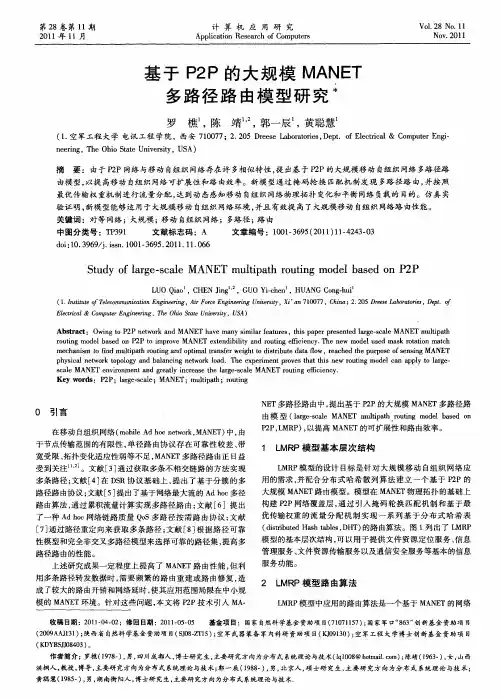

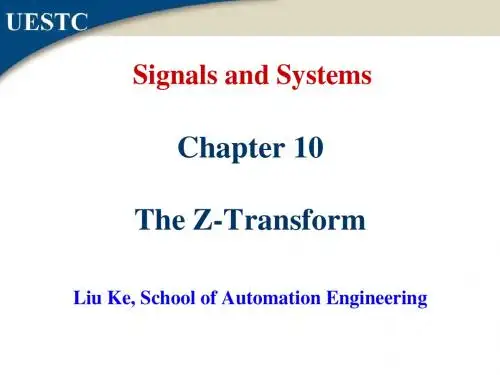
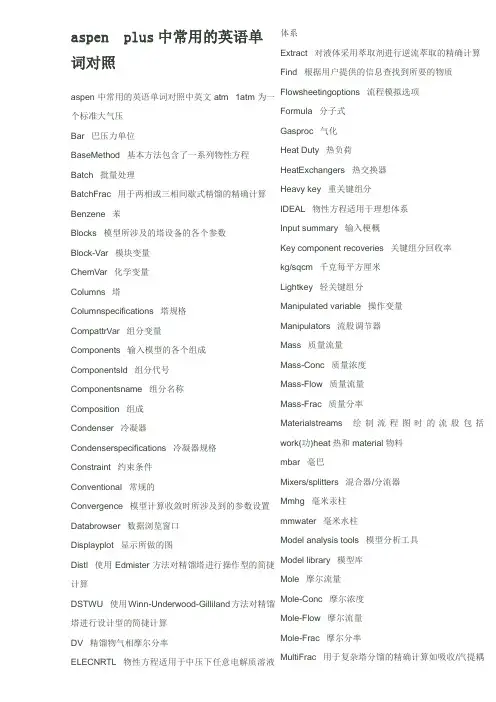
aspen plus中常用的英语单词对照aspen中常用的英语单词对照中英文atm 1atm为一个标准大气压Bar 巴压力单位BaseMethod 基本方法包含了一系列物性方程Batch 批量处理BatchFrac 用于两相或三相间歇式精馏的精确计算Benzene 苯Blocks 模型所涉及的塔设备的各个参数Block-Var 模块变量ChemVar 化学变量Columns 塔Columnspecifications 塔规格CompattrVar 组分变量Components 输入模型的各个组成ComponentsId 组分代号Componentsname 组分名称Composition 组成Condenser 冷凝器Condenserspecifications 冷凝器规格Constraint 约束条件Conventional 常规的Convergence 模型计算收敛时所涉及到的参数设置Databrowser 数据浏览窗口Displayplot 显示所做的图Distl 使用Edmister方法对精馏塔进行操作型的简捷计算DSTWU 使用Winn-Underwood-Gilliland方法对精馏塔进行设计型的简捷计算DV 精馏物气相摩尔分率ELECNRTL 物性方程适用于中压下任意电解质溶液体系Extract 对液体采用萃取剂进行逆流萃取的精确计算Find 根据用户提供的信息查找到所要的物质Flowsheetingoptions 流程模拟选项Formula 分子式Gasproc 气化Heat Duty 热负荷HeatExchangers 热交换器Heavy key 重关键组分IDEAL 物性方程适用于理想体系Input summary 输入梗概Key component recoveries 关键组分回收率kg/sqcm 千克每平方厘米Lightkey 轻关键组分Manipulated variable 操作变量Manipulators 流股调节器Mass 质量流量Mass-Conc 质量浓度Mass-Flow 质量流量Mass-Frac 质量分率Materialstreams 绘制流程图时的流股包括work(功)heat热和material物料mbar 毫巴Mixers/splitters 混合器/分流器Mmhg 毫米汞柱mmwater 毫米水柱Model analysis tools 模型分析工具Model library 模型库Mole 摩尔流量Mole-Conc 摩尔浓度Mole-Flow 摩尔流量Mole-Frac 摩尔分率MultiFrac 用于复杂塔分馏的精确计算如吸收/汽提耦合塔N/sqm 牛顿每平方米NSTAGE 塔板数Number of stages 塔板数OilGas 油气化Optimization 最优化Overallrange 灵敏度分析时变量变化范围Pa 国际标准压力单位PACKHEIGHT 填料高度Partial condenser with all vapor distillate 产品全部是气相的部分冷凝器Partial condenser with vapor and liquid distillate 有气液两相产品的部分冷凝器PBOT 塔底压力PENG-ROB 物性方程适用于所有温度及压力下的非极性或极性较弱的混合物体系Petchem 聚酯化合物PetroFrac 用于石油精炼中的分馏精确计算如预闪蒸塔Plot 图表PR-BM 物性方程适用于所有温度及压力下非极性或者极性较弱的体系Pressure 压力PressureChangers 压力转换设备PRMHV2 物性方程适用于较高温度及压力下极性或非极性的化合物混合体系Process type 处理类型Properties 输入各物质的物性Property methods & models 物性方法和模型psi 英制压力单位psig 磅/平方英寸(表压)PSRK 物性方程适用于较高温度及压力下极性或非极性的轻组分气体化合物体系PTOP 塔顶压力RadFrac 用于简单塔两相或三相分馏的精确计算RateFrac 用于基于非平衡模型的操作型分馏精确计算Reactions 模型中各种设备所涉及的反应Reactors 反应器ReactVar 反应变量Reboiler 再沸器RECOVH 重关键组分回收率RECOVL 轻关键组分回收率Refinery 精炼Reflux ratio 回流比Reinitialize 重新初始化Result summary 结果梗概Retrieve parameter results 结果参数检索RKS-BM 物性方程适用于所有温度及压力下非极性或者极性较弱的体系RKSMHV2 物性方程适用于较高温度及压力下极性或非极性的轻组分气体化合物体系RK-SOAVE 物性方程适用于所有温度及压力下的非极性或极性较弱的混合物体系RKSWS 物性方程适用于较高温度及压力下极性或非极性的轻组分气体化合物体系RR 回流比Run status 运行状态SCFrac 复杂塔的精馏简捷计算如常减压蒸馏塔和真空蒸馏塔Sensitivity 灵敏度Separators 分离器Solids 固体操作设备SR-POLAR 物性方程适用于较高温度及压力下极性或非极性的轻组分气体化合物体系State variables 状态变量Stdvol 标准体积流量Stdvol-Flow 标准体积流量Stdvol-Frac 标准体积分率Stream 各个输入输出组分的流股StreamVar 流股变量Substream name 分流股类型Temperature 温度Toluene 甲苯Torr 托真空度单位Total condenser 全凝器Total flow 总流量UNIQUAC 物性方程适用于极性和非极性强非理想体系UtilityVar 公用工程变量Vaiable number 变量数Vaporfraction 汽相分率Volume 体积流量XAxisvariable 作图时的横坐标变量YAxisvariable 作图时的纵坐标变量BERL:BERL Saddle贝尔鞍环BX:Sulzer BX苏尔寿BX型板波纹规整填料CMR:Cascade mini-ring 聚丙烯阶梯环COIL:COIL Pack环形填料CROSSFLGRD:Raschig Cross-Flow-Grid Structured PackCY:苏尔寿CY(丝网)型规整填料DIXON:DIXON Packing狄克松填料(θ环填料)FLEXERAMIC:Koch Flexeramic Structured Packing 柯赫曲线规整填料FLEXIGRID:Koch Flexigrid Structured Packing柯赫格栅规整填料FLEXIMAX:Koch Fleximax High Performance Random Packing柯赫高性能散堆填料FLEXIPAC:Koch Flexipac Corrugated Sheet Structured Packing柯赫柔性波纹板填料FLEXIRING:Koch Flexiring Single-tab Slotted Ring Random Packing柯赫单面环槽不规整填料FLEXISADDL:Koch Flexisaddle Random Packing 柯赫鞍形不规整填料GOODLOE:Glitsch Goodloe Structured Packing格里奇古德洛卷带型规整填料GRID:Glitsch Grid Structured Packing格里奇格栅规整填料GRID-PACK:Grid Type Structured Packing格栅规整填料HCKP:Koch HCKP Multi-tab Slotted Ring Random Packing 柯赫多面槽环形不规整填料HELI:Heli Pack螺旋填料HELIX:螺旋角填料HYPAK:I-BALL:I-Ball Packing I-球型填料IMTP:Intalox Metal Tower Packing英特洛克斯金属矩鞍环填料INTX:Intalox Saddle矩鞍环填料ISP:Norton Intalox Structured Packing诺顿规整填料KERAPAK:Sulzer Kerapak Structured Packing苏尔寿陶瓷板波纹填料(凯勒派克)LESCHIG:Leschig Ring浸环MCMAHON:Mcmahon Packing鞍形网填料MELLAPAK:Sulzer Mellapak Structured Packing苏尔寿孔板波纹填料MESH:Mesh Ring Packing筛网环形填料PALL:Pall Ring鲍尔环RALU-FLOW:Raschig Ralu-FlowRALU-PAK:Raschig Ralu-Pak拉西带缝板波填料RALU-RING:Raschig Ralu-Ring拉西Ralu环RASCHIG:Raschig Ring拉西环SHEET-PACK:Sheet Type Structured Packing SIGMA:Sigma PackingSNOWFLAKE:Intalox Snowflake Plastic Packing STORUSSDDL:Raschig Super-T orus-Saddle SUPER-INTX:Super Intalox SaddleSUPER-PAK:Rashig Super-PakSUPER-RING:Rashig Super-Ring TORUSSADDL:Raschig Torus SaddleWIRE-PACK:Wire Type Structured Packing三、常用词汇表(按菜单分类)1. Fileexit[`eksIt]退出export[ 5ekspC:t ]输出file[ fail ]文件import[ im5pC:t ]输入new[ nju: ]新的open[ 5EupEn ]打开print[prInt]印刷,打印save[ seiv ]保存send[ send ]发送Save as 另存Import EO variable 输入EOExport EO variable 输出EOPage setup 页面设置Print preview 打印预览Print setup 打印设置Send to 发送到2. Editclear[ kliE ]清除copy[ 5kCpi ]拷贝edit[ 5edit ]编辑form[ fC:m ]表格format[ 5fC:mAt ]格式化(磁盘)link[ liNk ]链接paste[ peist ]粘贴select[ si5lekt ]选择special[ 5speFEl ]特殊的Selected copy 选择拷贝Select all 全选3. Viewbar[bB:(r)]条control[kEn5trol]控制current[ 5kQrEnt ]当前的history[ 5histEri ]历史Page[ peidV ]页panel[ 5pAnl ]面板preview[ 5pri:5vju: ]预览report[ ri5pC:t ]报告reset[ 5ri:set ]重新安排solver[ 5sClvE ]求解器status[ 5steitEs ]状态summary[ 5sQmEri ]摘要Toolbar 工具栏view[ vju: ]视图zoom[zum]图象放大或者缩小status bar 状态栏model library 模型库control panel 控制面板page break preview 分页预览reset page break 重新分页current section only 仅显示当前段global data 全局[公用]数据annotation 注释OLE object 嵌入目标EO sync error EO 同步错误Input summary 输入规定汇总(输入语言) Solver report 求解器报告4. Data(1) Setupassay[ E5sei ]化验class[klB:s]分类option[ 5CpFEn ]选项report[ ri5pC:t ]报告setup[6set7(p]设置simulation[ 7simju5leiFEn ]模拟specification[ 7spesifi5keiFEn ]输入规stream[stri:m]流股unit[5ju:nIt]单位simulation option 模拟选项stream class 流股类型units-sets 单位集custom units 用户单位report option 报告选项(2) Componentsblend[blend] 混合characterization[7k#r*kt*i6zei.*n] component[k*m6poun*nt] 组成data[5deitE]数据define[di6fain] 给…下定义find[faind] 找到formula[6f%8rmj*l*]分子式analysis[*6n#lisis] 分析generation[7d/en*6rei.*n]生成group[gru8p]组library[6lai7breri8]库light[ lait ]轻的manager[6m#nid/*]管理method[6meG*d] 方法moisture[6m%ist.*] 湿气name[neim]名字object[6%bd/ikt] 目标petroleum[pI5trEJlIEm]石油polymer[5pRlImE(r)]聚合物procedure[prE5si:dVE(r)]程序pseudocomponent[5pEunEnt]虚拟组分reorderri:5C:dE(r)]重新,排序result[ri6z(lt] 结果review[rI5vju:]回顾selection[si6lek.*n] 选择specification[7spes*fi6kei.*n] 详细说明status[5steItEs]状态type[taip] 类型user [6ju8z*]使用者wizard[6wiz*d]向导assay/blend 化验/混合(油品分析与混合)light-end properties 轻端组分性质petro-characterization 油品表征attr-comps 组分属性henry comps 亨利组分moisture comps 湿气组分UNIFAC groups UNIFAC 参数组Comps-groups 组分分组comps-lists 组分列表Attr-Scaling 属性标量(3)Propertiesadvanced[ Ed5vB:nst ]高级的analysis[ E5nAlisis ]分析base[ beis ]基础calculation[ 7kAlkju5leiFEn ]计算compare[ kEm5pZE ]比较data[ 5deitE ]数据electrolyte[I5lektrEJlaIt]电解质estimation[ esti5meiFEn ]估算flowsheet[ flEu5Fi:t ]流程图global[ 5^lEubEl ]全局的input[ 5input ]输入method[5meWEd]方法missing[ 5misiN ]缺少molecular structure 分子结构molecular[ mEu5lekjulE ]分子的pair[ pZE ]一对parameter[ pE5rAmitE ]参数process[ prE5ses ]过程propaganda[prRpE5^AndE]宣传method[5meWEd]方法Prop-Sets 物性集pure[ pjuE ]纯的refectioner[rI`fekFEnE(r)]参考的route[ ru:t ]路线solubility[ 7sClju5biliti ]溶解度structure[ 5strQktFE ]结构ternary[ 5tE:nEri ]三重的user[ 5ju:zE ]使用者Property method 方法Prop-Sets 物性集molecular structure 分子结构CAPE-OPEN package CAPE-OPEN 物性数据包(4)Flowsheetadvanced[ Ed5vB:nst ]高级的analysis[ E5nAlisis ]分析base[ beis ]基础calculation[ 7kAlkju5leiFEn ]计算compare[ kEm5pZE ]比较data[ 5deitE ]数据electrolyte[I5lektrEJlaIt]电解质estimation[ esti5meiFEn ]估算flowsheet[ flEu5Fi:t ]流程图global[ 5^lEubEl ]全局的input[ 5input ]输入method[5meWEd]方法missing[ 5misiN ]丢失molecular structure 分子结构molecular[ mEu5lekjulE ]分子的pair[ pZE ]一对parameter[ pE5rAmitE ]参数process[ prE5ses ]过程propaganda[prRpE5^AndE]宣传method[5meWEd]方法Prop-Sets 物性急pure[ pjuE ]纯的refectioner[rI`fekFEnE(r)]参考的route[ ru:t ]路径solubility[ 7sClju5biliti ]溶度structure[ 5strQktFE ]结构ternary[ 5tE:nEri ]三重的user[ 5ju:zE ]使用者flowsheet[flEu5Fi:t]工艺流程图global[6gloub*l] 全局的section[5sekF(E)n]流程分段(5)Streamsstream[stri:m]流股(6)Utilitiesutility[ ju:5tiliti ]公用工程(7)Blocksblock[ blCk ](8)Reactionschemistry[ 5kemistri ]化学reaction[ ri(:)5AkFEn ]反应convergence[ kEn`v\:dVEns ]收敛(9)Convergenceconvergence[k*n6v*8d/*ns] 收敛default[di6f%8lt] 默认method[6meG*d] 方法sequence[6si8kw*ns] 顺序tear[tW*r] 撕裂、断裂Conv options 收敛选项EO Conv options EO 收敛选项Conv order 收敛次序(10)Flowsheeting Optionsadd[#d] 添加balance[5bAlEns]平衡calculator[5kAlkjJleItE(r)]计算器design[dI5zaIn]设计flowsheet[ flEu5Fi:t ]流程图measurement[ 5meVEmEnt ]测量relief[ ri5li:f ]释放specification[ 7spesifi5keiFEn ]说明书、详述transfer[ trAns5fE:]传递Design spec 设计规定Stream library 流股库Pres relief 压力释放(安全排放) Add input 添加输入(11)Model Analysis Tools analysis[E5nAlEsIs]分析study[5stQdi]研究case[kes] 工况constraint[kEn5streInt]约束cost[k%st] 成本estimation[esti5meiFEn]估算model[ 5mCdl ]模型、模拟optimization[Cptimai5zeiFEn]优化sensitivity[sensI5tIvItI]灵敏度tool[tu8l] 工具model analysis tool 模型分析工具Data fit 数据拟合case study 工况研究cost estimation 成本估算(12)EO Configurationalias[5eIlIEs]又名,别名configuration[kEn9fI^jE5reFEn]配置connection[kE5nekF(E)n]连接global[5^lobl]全局的group[^ru:p]组local[ 5lEukEl ]局部的objective[Eb5dVektiv]目标script[skrIpt]脚本solve[ sClv ]求解variable[5vZEriEbl]变量Solve option 求解选项EO variable EO 变量EO input EO 输入Spec group 规定组EO Option EO 选项local script 局部的脚本global script 全局的脚本script method 脚本方法EO sensitivity EO 灵敏度(13)Result Summary convergence[ kEn`v\:dVEns ]收敛run[rQn]运算status[ 5steitEs ]状态stream[ stri:m ]流股utility[ ju:5tiliti ]公用工程run status 运行状态5. ToolAnalysis [E5nAlEsIs] 分析Assistant [E5sIst(E)nt] 帮助、助理Clean [kli8n] 清除concatenate[k%n6k#tn7eit] 连结conceptual[kEn5septFuEl]概念的design[ di5zain ]设计explorer[ iks5plC:rE]资源管理器next[ nekst ]下一次, 下一个option[ 5CpFEn ]选项package[ 5pAkidV ]包parameter[ pE5rAmitE ]参数result[ ri5zQlt ]结果retrieve[ ri5tri:v ]重新得到(调用)tool[ tu:l ]工具variable[ 5vZEriEbl ]变量retrieve parameter result 调用物性数据库参数结果Clean property parameter 清除物性参数Property Method selection assistant 物性方法选择帮助conceptual design 概念[方案]设计import CAPE-OPEN package 输入CAPE-OPEN 数据包export CAPE-OPEN package 输出CAPE-OPEN 数据包variable explorer 变量管理器6. Runbatch[ bAtF ]一批check[ tFek ]检查connect[ kE5nekt ]连接load[ lEud ]装载move[ mu:v ]移动point[pCInt]指向reconcile[ 5rekEnsail ]调谐recover[ ri5kQvE ]恢复Reinitialize 初始化reset[ 5ri:set ]重新安排result[ ri5zQlt ]结果run[ rQn ]运算setting 安置stop[ stCp ]停止Stop point 停止点Reset EO variable 重新安排EO 变量recover EO variable 恢复EO 变量check result 检查结果load result 加载结果reconcile all 调谐reconcile all stream 调谐全部流股connect to engine 连接模拟器(技术主程序)7. plotadd[Ad]加curve[ kE:v ]曲线display[dI5spleI]显示plot[ plCt ]绘图type[ taip ]类型variable[ 5vZEriEbl ]变量wizard[ 5wizEd ]向导x-axis[`eks9AksIs]X 轴plot type 绘图类型x-axis variable 变量做X 轴Y-axis variable 变量做Y 轴Parametric variable 变量做参(变)量display plot 显示图add new curve 增加新的曲线plot wizard 绘图向导8. Flowsheetflowsheet[ flEu5Fi:t ]流程图section[ 5sekFEn ]部分,段reconnect[ri:kE5nekt]重新连接source[ sC:s ]来源destination[ 7desti5neiFEn ]目的地exchange[ iks5tFeindV ]交换icon[5aIkRn]图标align[E5lain]排成直线block[5blCks]模块reroute[ ri5ru:t, -5raut ]变更路径stream[stri:m]流股hide[ haid ]隐藏unplaced[ 5Qn5pleist ]取消放置group[ ^ru:p ]组find[ faind ]找object[ 5CbdVikt ]目标lock[ lCk ]锁flowsheet section 流程段reconnect source 重新连接流股来源reconnect destination重新连接流股目的地exchange icon 更换设备图标align block 使模块排成直线reroute stream 变更流股路径unplaced blocks 取消放置模块find object 查找目标9. Librarybuilt-in[ 5bilt5in ]内置category[ 5kAti^Eri ]种类default[ di5fC:lt ]默认icon[5aIkRn]图标library[ 5laibrEri ]库palette[ 5pAlit ]调色板, 颜料problem [ 5prCblEm ]问题, 难题reference[ 5refrEns ]参考save[ seiv ]保存Palette category 调色种类save default 默认保存save icon 保存图标built-in 内置10. Windowarrange icons 重排图标cascade[ kAs5keid ]层叠icon[5aIkRn]图标normal[ 5nC:mEl ]常规的tile[ tail ]平铺wallpaper[5wC:lpeIpE(r)]壁纸window[5wIndEJ]窗口workbook[5w\:kbJk]练习簿方式arrange icons 重排图标flowsheet as wallpaper 流程设置为壁纸11. Helpabout[ 5Ebaut ]关于help[help]帮助plus[plQs]加的product[ 5prCdEkt ]产品readme 自述文件support [ sE5pC:t ]支持topic[ 5tCpik ]主题training[ 5treiniN ]训练update[ Qp5deit ]更新view[ vju: ]视图web[web]网what[ (h)wCt ]什么help topic 帮助主题what′s this 这是什么?product support on the web 互联网产品支持view update readme 查看软件更新自述文件about aspen plus 关于aspen plusaspen中常用的英语单词对照A英文缩写全称A/MMA 丙烯腈/甲基丙烯酸甲酯共聚物AA 丙烯酸AAS 丙烯酸酯-丙烯酸酯-苯乙烯共聚物ABFN 偶氮(二)甲酰胺ABN 偶氮(二)异丁腈ABPS 壬基苯氧基丙烷磺酸钠B 英文缩写全称BAA 正丁醛苯胺缩合物BAC 碱式氯化铝BACN 新型阻燃剂BAD 双水杨酸双酚A酯BAL 2,3-巯(基)丙醇BBP 邻苯二甲酸丁苄酯BBS N-叔丁基-乙-苯并噻唑次磺酰胺化学物质缩写BC 叶酸BCD β-环糊精BCG 苯顺二醇BCNU 氯化亚硝脲BD 丁二烯BE 丙烯酸乳胶外墙涂料BEE 苯偶姻乙醚BFRM 硼纤维增强塑料BG 丁二醇BGE 反应性稀释剂BHA 特丁基-4羟基茴香醚BHT 二丁基羟基甲苯BL 丁内酯BLE 丙酮-二苯胺高温缩合物BLP 粉末涂料流平剂BMA 甲基丙烯酸丁酯BMC 团状模塑料BMU 氨基树脂皮革鞣剂BN 氮化硼BNE 新型环氧树脂BNS β-萘磺酸甲醛低缩合物BOA 己二酸辛苄酯BOP 邻苯二甲酰丁辛酯BOPP 双轴向聚丙烯BP 苯甲醇BPA 双酚ABPBG 邻苯二甲酸丁(乙醇酸乙酯)酯BPF 双酚FBPMC 2-仲丁基苯基-N-甲基氨基酸酯BPO 过氧化苯甲酰BPP 过氧化特戊酸特丁酯BPPD 过氧化二碳酸二苯氧化酯BPS 4,4’-硫代双(6-特丁基-3-甲基苯酚) BPTP 聚对苯二甲酸丁二醇酯BR 丁二烯橡胶BRN 青红光硫化黑BROC 二溴(代)甲酚环氧丙基醚BS 丁二烯-苯乙烯共聚物BS-1S 新型密封胶BSH 苯磺酰肼BSU N,N’-双(三甲基硅烷)脲BT 聚丁烯-1热塑性塑料BTA 苯并三唑BTX 苯-甲苯-二甲苯混合物BX 渗透剂BXA 己二酸二丁基二甘酯BZ 二正丁基二硫代氨基甲酸锌C英文缩写全称CA 醋酸纤维素CAB 醋酸-丁酸纤维素CAN 醋酸-硝酸纤维素CAP 醋酸-丙酸纤维素CBA 化学发泡剂CDP 磷酸甲酚二苯酯CF 甲醛-甲酚树脂,碳纤维CFE 氯氟乙烯CFM 碳纤维密封填料CFRP 碳纤维增强塑料CLF 含氯纤维CMC 羧甲基纤维素CMCNa 羧甲基纤维素钠CMD 代尼尔纤维CMS 羧甲基淀粉D英文缩写全称DAF 富马酸二烯丙酯DAIP 间苯二甲酸二烯丙酯DAM 马来酸二烯丙酯DAP 间苯二甲酸二烯丙酯DATBP 四溴邻苯二甲酸二烯丙酯DBA 己二酸二丁酯DBEP 邻苯二甲酸二丁氧乙酯DBP 邻苯二甲酸二丁酯DBR 二苯甲酰间苯二酚DBS 癸二酸二癸酯DCCA 二氯异氰脲酸DCCK 二氯异氰脲酸钾DCCNa 二氯异氰脲酸钠DCHP 邻苯二甲酸二环乙酯DCPD 过氧化二碳酸二环乙酯DDA 己二酸二癸酯DDP 邻苯二甲酸二癸酯DEAE 二乙胺基乙基纤维素DEP 邻苯二甲酸二乙酯DETA 二乙撑三胺DFA 薄膜胶粘剂DHA 己二酸二己酯DHP 邻苯二甲酸二己酯DHS 癸二酸二己酯DIBA 己二酸二异丁酯DIDA 己二酸二异癸酯DIDG 戊二酸二异癸酯DIDP 邻苯二甲酸二异癸酯DINA 己二酸二异壬酯DINP 邻苯二甲酸二异壬酯DINZ 壬二酸二异壬酯DIOA 己酸二异辛酯< lan>E英文缩写全称E/EA 乙烯/丙烯酸乙酯共聚物E/P 乙烯/丙烯共聚物E/P/D 乙烯/丙烯/二烯三元共聚物E/TEE 乙烯/四氟乙烯共聚物E/VAC 乙烯/醋酸乙烯酯共聚物E/VAL 乙烯/乙烯醇共聚物EAA 乙烯-丙烯酸共聚物EAK 乙基戊丙酮EBM 挤出吹塑模塑EC 乙基纤维素ECB 乙烯共聚物和沥青的共混物ECD 环氧氯丙烷橡胶ECTEE 聚(乙烯-三氟氯乙烯) ED-3 环氧酯EDC 二氯乙烷EDTA 乙二胺四醋酸EEA 乙烯-醋酸丙烯共聚物EG 乙二醇2-EH :异辛醇EO 环氧乙烷EOT 聚乙烯硫醚EP 环氧树脂EPI 环氧氯丙烷EPM 乙烯-丙烯共聚物EPOR 三元乙丙橡胶EPR 乙丙橡胶EPS 可发性聚苯乙烯EPSAN 乙烯-丙烯-苯乙烯-丙烯腈共聚物EPT 乙烯丙烯三元共聚物EPVC 乳液法聚氯乙烯EU 聚醚型聚氨酯EVA 乙烯-醋酸乙烯共聚物EVE 乙烯基乙基醚EXP 醋酸乙烯-乙烯-丙烯酸酯三元共聚乳液F英文缩写全称F/VAL 乙烯/乙烯醇共聚物F-23 四氟乙烯-偏氯乙烯共聚物F-30 三氟氯乙烯-乙烯共聚物F-40 四氟氯乙烯-乙烯共聚物FDY 丙纶全牵伸丝FEP 全氟(乙烯-丙烯)共聚物FNG 耐水硅胶FPM 氟橡胶FRA 纤维增强丙烯酸酯FRC 阻燃粘胶纤维FRP 纤维增强塑料FRPA-101 玻璃纤维增强聚癸二酸癸胺(玻璃纤维增强尼龙1010树脂) FRPA-610 玻璃纤维增强聚癸二酰乙二胺(玻璃纤维增强尼龙610树脂) FWA 荧光增白剂G英文缩写全称GF 玻璃纤维GFRP 玻璃纤维增强塑料GFRTP 玻璃纤维增强热塑性塑料促进剂GOF 石英光纤GPS 通用聚苯乙烯GR-1 异丁橡胶GR-N 丁腈橡胶GR-S 丁苯橡胶GRTP 玻璃纤维增强热塑性塑料GUV 紫外光固化硅橡胶涂料GX 邻二甲苯GY 厌氧胶H英文缩写全称H 乌洛托品HDI 六甲撑二异氰酸酯HDPE 低压聚乙烯(高密度)HEDP 1-羟基乙叉-1,1-二膦酸HFP 六氟丙烯HIPS 高抗冲聚苯乙烯HLA 天然聚合物透明质胶HLD 树脂性氯丁胶HM 高甲氧基果胶HMC 高强度模塑料HMF 非干性密封胶HOPP 均聚聚丙烯HPC 羟丙基纤维素HPMC 羟丙基甲基纤维素HPMCP 羟丙基甲基纤维素邻苯二甲酸酯HPT 六甲基磷酸三酰胺HS 六苯乙烯HTPS 高冲击聚苯乙烯I英文缩写全称IEN 互贯网络弹性体IHPN 互贯网络均聚物IIR 异丁烯-异戊二烯橡胶IO 离子聚合物IPA 异丙醇IPN 互贯网络聚合物IR 异戊二烯橡胶IVE 异丁基乙烯基醚J英文缩写全称JSF 聚乙烯醇缩醛胶JZ 塑胶粘合剂K英文缩写全称KSG 空分硅胶L英文缩写全称LAS 十二烷基苯磺酸钠LCM 液态固化剂LDJ 低毒胶粘剂LDN 氯丁胶粘剂LDPE 高压聚乙烯(低密度)LDR 氯丁橡胶LF 脲LGP 液化石油气LHPC 低替代度羟丙基纤维素LIM 液体侵渍模塑LIPN 乳胶互贯网络聚合物LJ 接体型氯丁橡胶LLDPE 线性低密度聚乙烯LM 低甲氧基果胶LMG 液态甲烷气LMWPE 低分子量聚乙稀LN 液态氮LRM 液态反应模塑LRMR 增强液体反应模塑LSR 羧基氯丁乳胶M英文缩写全称MA 丙烯酸甲酯MAA 甲基丙烯酸MABS 甲基丙烯酸甲酯-丙烯腈-丁二烯-苯乙烯共聚物MAL 甲基丙烯醛MBS 甲基丙烯酸甲酯-丁二烯- 苯乙烯共聚物MBTE 甲基叔丁基醚MC 甲基纤维素MCA 三聚氰胺氰脲酸盐MCPA-6 改性聚己内酰胺(铸型尼龙6)MCR 改性氯丁冷粘鞋用胶MDI 3,3’-二甲基-4,4’-二氨基二苯甲烷MDI 二苯甲烷二异氰酸酯(甲撑二苯基二异氰酸酯) MDPE 中压聚乙烯(高密度) MEK 丁酮(甲乙酮)MEKP 过氧化甲乙酮MES 脂肪酸甲酯磺酸盐MF 三聚氰胺-甲醛树脂M-HIPS 改性高冲聚苯乙烯MIBK 甲基异丁基酮MMA 甲基丙烯酸甲酯MMF 甲基甲酰胺MNA 甲基丙烯腈MPEG 乙醇酸乙酯MPF 三聚氨胺-酚醛树脂MPK 甲基丙基甲酮M-PP 改性聚丙烯MPPO 改性聚苯醚MPS 改性聚苯乙烯MS 苯乙烯-甲基丙烯酸甲酯树脂MSO 石油醚MTBE 甲基叔丁基醚MTT 氯丁胶新型交联剂MWR 旋转模塑MXD-10/6 醇溶三元共聚尼龙MXDP 间苯二甲基二胺N英文缩写全称NBR 丁腈橡胶NDI 二异氰酸萘酯NDOP 邻苯二甲酸正癸辛酯NHDP 邻苯二甲酸己正癸酯NHTM 偏苯三酸正己酯NINS 癸二酸二异辛酯NLS 正硬脂酸铅NMP N-甲基吡咯烷酮NODA 己二酸正辛正癸酯NODP 邻苯二甲酸正辛正癸酯NPE 壬基酚聚氧乙烯醚NR 天然橡胶O英文缩写全称OBP 邻苯二甲酸辛苄酯ODA 己二酸异辛癸酯ODPP 磷酸辛二苯酯OIDD 邻苯二甲酸正辛异癸酯OPP 定向聚丙烯(薄膜)OPS 定向聚苯乙烯(薄膜)OPVC 正向聚氯乙烯OT 气熔胶P英文缩写全称PA 聚酰胺(尼龙)PA-1010 聚癸二酸癸二胺(尼龙1010) PA-11 聚十一酰胺(尼龙11)PA-12 聚十二酰胺(尼龙12)PA-6 聚己内酰胺(尼龙6)PA-610 聚癸二酰乙二胺(尼龙610)PA-612 聚十二烷二酰乙二胺(尼龙612) PA-66 聚己二酸己二胺(尼龙66)PA-8 聚辛酰胺(尼龙8)PA-9 聚9-氨基壬酸(尼龙9)PAA 聚丙烯酸PAAS 水质稳定剂PABM 聚氨基双马来酰亚胺PAC 聚氯化铝PAEK 聚芳基醚酮PAI 聚酰胺-酰亚胺PAM 聚丙烯酰胺PAMBA 抗血纤溶芳酸PAMS 聚α-甲基苯乙烯PAN 聚丙烯腈PAP 对氨基苯酚PAPA 聚壬二酐PAPI 多亚甲基多苯基异氰酸酯PAR 聚芳酰胺PAR 聚芳酯(双酚A型)PAS 聚芳砜(聚芳基硫醚)PB 聚丁二烯-[1,3]PBAN 聚(丁二烯-丙烯腈)PBI 聚苯并咪唑PBMA 聚甲基丙烯酸正丁酯PBN 聚萘二酸丁醇酯PBR 丙烯-丁二烯橡胶PBS 聚(丁二烯-苯乙烯)PBS 聚(丁二烯-苯乙烯)PBT 聚对苯二甲酸丁二酯PC 聚碳酸酯PC/ABS 聚碳酸酯/ABS树脂共混合金PC/PBT 聚碳酸酯/聚对苯二甲酸丁二醇酯弹性体共混合金PCD 聚羰二酰亚胺PCDT 聚(1,4-环己烯二亚甲基对苯二甲酸酯)PCE 四氯乙烯PCMX 对氯间二甲酚PCT 聚对苯二甲酸环己烷对二甲醇酯PCT 聚己内酰胺PCTEE 聚三氟氯乙烯PD 二羟基聚醚PDAIP 聚间苯二甲酸二烯丙酯PDAP 聚对苯二甲酸二烯丙酯PDMS 聚二甲基硅氧烷R英文缩写全称RE 橡胶粘合剂RF 间苯二酚-甲醛树脂RFL 间苯二酚-甲醛乳胶RP 增强塑料RP/C 增强复合材料RX 橡胶软化剂S英文缩写全称S/MS 苯乙烯-α-甲基苯乙烯共聚物SAN 苯乙烯-丙烯腈共聚物SAS 仲烷基磺酸钠SB 苯乙烯-丁二烯共聚物SBR 丁苯橡胶SBS 苯乙烯-丁二烯-苯乙烯嵌段共聚物SC 硅橡胶气调织物膜SDDC N,N-二甲基硫代氨基甲酸钠SE 磺乙基纤维素SGA 丙烯酸酯胶SI 聚硅氧烷SIS 苯乙烯-异戊二烯-苯乙烯嵌段共聚物SIS/SEBS 苯乙烯-乙烯-丁二烯- 苯乙烯共聚物SM 苯乙烯SMA 苯乙烯-顺丁烯二酸酐共聚物SPP :间规聚苯乙烯SPVC 悬浮法聚氯乙烯SR 合成橡胶ST 矿物纤维T英文缩写全称TAC 三聚氰酸三烯丙酯TAME 甲基叔戊基醚TAP 磷酸三烯丙酯TBE 四溴乙烷TBP 磷酸三丁酯TCA 三醋酸纤维素TCCA 三氯异氰脲酸TCEF 磷酸三氯乙酯TCF 磷酸三甲酚酯TCPP 磷酸三氯丙酯TDI 甲苯二异氰酸酯TEA 三乙胺TEAE 三乙氨基乙基纤维素TEDA 三乙二胺TEFC 三氟氯乙烯TEP 磷酸三乙酯TFE 四氟乙烯THF 四氢呋喃TLCP 热散液晶聚酯TMP 三羟甲基丙烷TMPD 三甲基戊二醇TMTD 二硫化四甲基秋兰姆(硫化促进剂TT)TNP 三壬基苯基亚磷酸酯TPA 对苯二甲酸TPE 磷酸三苯酯TPS 韧性聚苯乙烯TPU 热塑性聚氨酯树脂TR 聚硫橡胶TRPP 纤维增强聚丙烯TR-RFT 纤维增强聚对苯二甲酸丁二醇酯TRTP 纤维增强热塑性塑料TTP 磷酸二甲苯酯U英文缩写全称U 脲UF 脲甲醛树脂UHMWPE 超高分子量聚乙烯UP 不饱和聚酯VVAC 醋酸乙烯酯VAE 乙烯-醋酸乙烯共聚物VAM 醋酸乙烯VAMA 醋酸乙烯-顺丁烯二酐共聚物VC 氯乙烯VC/CDC 氯乙烯/偏二氯乙烯共聚物VC/E 氯乙烯/乙烯共聚物VC/E/MA 氯乙烯/乙烯/丙烯酸甲酯共聚物VC/E/VAC 氯乙烯/乙烯/醋酸乙烯酯共聚物VC/MA 氯乙烯/丙烯酸甲酯共聚物VC/MMA 氯乙烯/甲基丙烯酸甲酯共聚物VC/OA 氯乙烯/丙烯酸辛酯共聚物VC/VAC 氯乙烯/醋酸乙烯酯共聚物VCM 氯乙烯(单体)VCP 氯乙烯-丙烯共聚物VCS 丙烯腈-氯化聚乙烯-苯乙烯共聚物VDC 偏二氯乙烯VPC 硫化聚乙烯VTPS 特种橡胶偶联剂W英文缩写全称WF 新型橡塑填料WP 织物涂层胶WRS 聚苯乙烯球形细粒X英文缩写全称XF 二甲苯-甲醛树脂XMC 复合材料Y英文缩写全称YH 改性氯丁胶YM 聚丙烯酸酯压敏胶乳YWG 液相色谱无定型微粒硅胶Z英文缩写全称ZE 玉米纤维ZH 溶剂型氯化天然橡胶胶粘剂ZN 粉状脲醛树脂胶此外,有关化学试剂按杂质含量的多少分:实验试剂:缩写为LR,又称四级试剂。
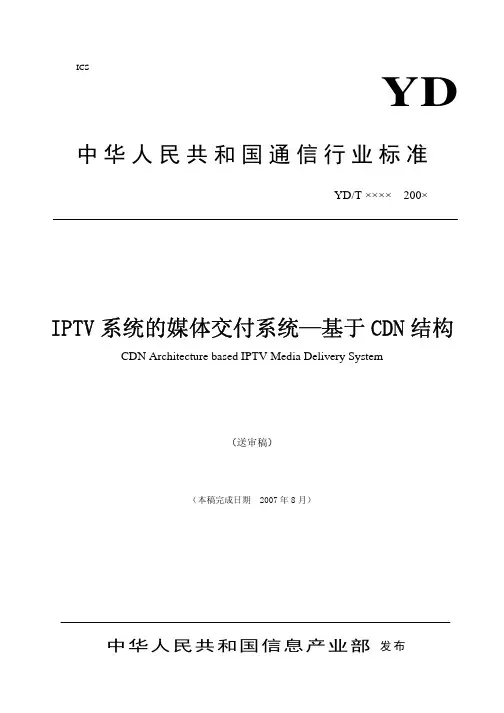
ICSYD 中华人民共和国通信行业标准YD/T ××××—200×IPTV系统的媒体交付系统—基于CDN结构CDN Architecture based IPTV Media Delivery System(送审稿)(本稿完成日期 2007年8月)中华人民共和国信息产业部发布目 次1范围 (4)2规范性引用文件 (4)3定义与系统需求 (4)4缩略语 (6)5体系架构 (7)6节点功能要求 (14)7CDN网络组建要求 (27)8安全技术要求 (31)9操作维护要求 (32)10接口通信协议 (37)11性能要求 (38)12可靠性要求 (38)前言本标准是IPTV业务系统系列标准之一。
该系列标准的结构和名称预计如下:1.IPTV范围,定义和场景2.IPTV系统的媒体交付系统——基于CDN结构3.IPTV系统的业务运营管理系统体系架构4.IPTV承载网络体系结构5.IPTV对接入网络的技术要求6.IPTV网络管理系统体系架构7.IPTV终端的管理8.IPTV终端设备测试方法9.IPTV终端机卡分离技术要求本标准是IPTV系统的媒体交付系统——基于CDN结构,它是针对IPTV的CDN内容分发网络提出的技术要求。
本标准以YD/T XXXX-200X《IPTV系统的媒体交付系统——基于CDN结构》为基础,规定了IPTV的CDN内容分发网络的结构、功能、性能、互通性、网管、接口、分发流程等方面的技术要求。
它是IPTV的CDN设备研制、生产、入网、选型和验收测试的主要依据。
本标准由中国通信标准化协会提出并归口。
本标准起草单位:中兴通讯股份有限公司、信息产业部电信研究院、中国电信集团公司、中国网络通信集团公司、UT斯达康通信有限公司、上海贝尔阿尔卡特股份有限公司、华为技术有限公司本标准主要起草人:IPTV系统的媒体交付系统——基于CDN结构1 范围本标准规定了国内开展IPTV业务所需的基于CDN结构的媒体交付系统的架构,CDN 网络组建结构,节点的功能要求,系统接口,操作维护,性能要求和可靠性要求。

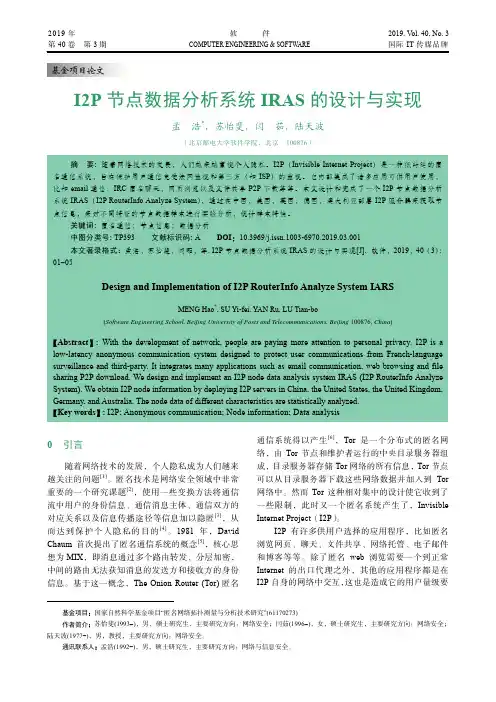
2019年 软 件 2019, Vol. 40, No. 3 第40卷 第3期 COMPUTER ENGINEERING & SOFTWARE 国际IT传媒品牌
基金项目: 国家自然科学基金项目“匿名网络拓扑测量与分析技术研究”(61170273) 作者简介: 苏怡斐(1993),男,硕士研究生,主要研究方向:网络安全;闫茹(1996),女,硕士研究生,主要研究方向:网络安全;陆天波(1977),男,教授,主要研究方向:网络安全。
通讯联系人: 孟浩(1992),男,硕士研究生,主要研究方向:网络与信息安全。
I2P节点数据分析系统IRAS的设计与实现 孟 浩*,苏怡斐,闫 茹,陆天波 (北京邮电大学软件学院,北京 100876)
摘 要: 随着网络技术的发展,人们越来越重视个人隐私。I2P(Invisible Internet Project)是一种低时延的匿名通信系统,旨在保护用户通信免受法网监视和第三方(如ISP)的监视。它内部集成了诸多应用可供用户使用,比如email通信,IRC匿名聊天,网页浏览以及文件共享P2P下载等等。本文设计和完成了一个I2P节点数据分析系统IRAS(I2P RouterInfo Analyze System),通过在中国,美国,英国,德国,澳大利亚部署I2P服务器来获取节点信息,来对不同特征的节点数据样本进行实验分析,统计样本特性。 关键词: 匿名通信;节点信息;数据分析 中图分类号: TP393 文献标识码: A DOI:10.3969/j.issn.1003-6970.2019.03.001 本文著录格式:孟浩,苏怡斐,闫茹,等. I2P节点数据分析系统IRAS的设计与实现[J]. 软件,2019,40(3):0105
Design and Implementation of I2P RouterInfo Analyze System IARS MENG Hao*, SU Yi-fei, YAN Ru, LU Tian-bo (Software Engineering School, Beijing University of Posts and Telecommunications, Beijing 100876, China)
method of merging and fitting data files from two well-known TSI aerosol instruments to produce wide-range particle size distribution curves for) spectrometer is the most accurate sizer for coarse particles. The advantage of combining these two measurement techniques is that they are related and, unlikeGET A WIDER VIEWOF THE PARTICLE RANGE!32The Data Merge Software enables users to quickly and easily merge andfit SMPS and APS data files to produce single particle size distributions.Multimodal distribution functions can be fitted to the data, coveringall three modes of particles found in the atmosphere, namely nuclei-,accumulation-, and coarse-mode aerosols. The software is designedto work with a variety of SMPS spectrometers (Model 3034 and Series3934/3936) and APS spectrometers (Models 3310, 3310A, 3320, and3321). The instruments may use any version of TSI Aerosol InstrumentManager® software. As a result, wide-range particle size distributionsfrom 0.0025 to 20 μm can be created, with the lower limit determined bythe SMPS configuration.Get a Wider View of the Particle Size Range!Size distributions of airborne particles often span a wide size rangefrom a few nanometers to several micrometers, which typically exceedsthe measurement size range of any one instrument. Researchers havefrequently combined data from multiple instruments, but details of thedata conversion between units have varied. Because particle sizers oftenuse different measurement principles, the units of measure are oftendifferent, too (for example, electrical mobility diameter, aerodynamicdiameter, etc.).Features and BenefitsThe Data Merge Software offers these important features and benefits:Data merging. SMPS and APS data can be merged into a single,composite data set to create wide-range particle size distributions from0.0025 to 20 μm.Curve-fitting. The software fits a set of data to unimodal, bimodal, ortrimodal distribution functions, based on user inputs. Y ou may also selectlognormal, Rosin-Rammler, or automatic fit functions. For lognormaldistributions, the geometric mean and geometric standard deviation foreach mode are provided in tabular form. Our fitting algorithms are basedon the proven DISTFIT† program for general data merging and fitting inparticle measuring technology.Ease of use. The software module can be accessed from withinTSI’s Aerosol Instrument Manager software or used as a stand-aloneprogram. It features a browser that allows user’s to select data files.Users can merge and fit data by selecting:+ Individual files+ Batch mode to merge large sets of data+ Averaging groups of like data files+ Specific time intervals or datesFlexible data management. The software features a variety ofgraph settings to view and adjust individual size distributions andthe composite fit. Once merged, data can be “windowed” to adjust thegoodness of fit and display the statistics of each mode. Graphical andtabular data can be printed, copied to the clipboard, and saved.Merged data can be exported in a variety of formats. Also, it can beexpressed in units of electrical mobility diameter or aerodynamicdiameter. Users enter a shape factor and density to get a “best fit.”The software allows for weighted moments of number, includingsurface area, volume, and mass. Additionally, data files includeinformation on the source (file name, sample numbers, etc.) of thedata used.Saves time. This software processes large amounts of dataefficiently and alleviates a tedious task that used to take weeks oreven months to complete.3different resolutions, and overlap in the fine-mode region, the Data Merge Software combines SMPS and APS data to create a new data set in the particle size range from 0.0025 to 20 μm.Simply select the data files you want to merge. The software allows you to select data files from one or multiple samples and combine the averaged data separately for each instrument. Data merging always requires converting the aerodynamic diameter number concentration data set to mobility diameter by entering the particle density andshape factor. Once merged, the composite fit can be displayed in unitsdata from the individual instruments, or the merged and fitted data. Distribution modes can be summed or plotted separately using either linear or log scaling. The range limit for each instrument can be displayed and adjusted (that is, “windowed”) to control the data used for fitting and to calculate the goodness of fit and statistical summary information.A Merge Settings menu provides additional controls. Users may select from a variety of fit functions such as lognormal, Rosin-Rammler, or automatic, as well as select unimodal, bimodal, and trimodal distribution functions.DATA MERGE SOFTWARE MODULE MODEL 390069SPECIFICATIONSTSI Incorporated - Visit our website for more A Tel: +1 800 874 2811UK Tel: +44 149 4 459200France Tel: +33 4 91 11 87 64Germany Tel: +49 241 523030India Tel: +91 80 67877200China Tel: +86 10 8219 7688 Singapore Tel: +65 6595 6388Printed in U.S.A.UNDERSTANDING, ACCELERATEDP/N 5001617 (A4) Rev C©2014 TSI IncorporatedData File FormatRequires SMPS and APS data files in the format of TSI Aerosol Instrument Manager ® softwareComputer RequirementsPentium ® 4 processor, 2 GHz speed or better, at least 512 MB RAM Operating System Required Microsoft Windows ® 2000 or XPSpecifications are subject to change without notice. TSI and the TSI logo are registered trademarks of TSI Incorporated.TSI, the TSI logo, Scanning Mobility Particle Sizer, SMPS, Aerodynamic Particle Sizer, APS, and Aerosol Instrument Manager are trademarks of TSI Incorporated. Windows is a trademark of Microsoft Corporation. Pentium is a trademark of Intel Corporation.AcknowledgmentThe Model 390069 Data Merge Software module was developed by TSI under agreement with Chimera Technologies, Inc., of Forest Lake, MN, USA. We gratefully acknowledge the contributions from the people at Chimera Technologies, Inc., during the development of this product.To OrderData Merge Software Module Specify Description 390069 Software on CD-ROM and operation manual。
INL/EXT-07-12536Rev. 1 Battery Test Manual for Plug-In Hybrid Electric VehiclesSeptember 2010The INL is a U.S. Department of Energy National Laboratoryoperated by Battelle Energy AllianceINL/EXT-07-12536Rev. 1 Battery Test Manual for Plug-In Hybrid ElectricVehiclesSeptember 2010Idaho National LaboratoryIdaho Falls, Idaho 83415Prepared for theU.S. Department of EnergyAssistant Secretary for Energy Efficiency and Renewable EnergyUnder DOE Idaho Operations OfficeContract DE-AC07-05ID14517INL/EXT-07-12536 U.S. Department of EnergyVehicle Technologies ProgramBattery Test ManualFor Plug-In Hybrid Electric VehiclesREVISION 1SEPTEMBER 2010The Idaho National Laboratory is a U.S. Department of Energy NationalLaboratoryOperated by Battelle Energy AllianceFOREWORDThis battery test procedure manual was prepared for the United States Department of Energy (DOE), Office of Energy Efficiency and Renewable Energy (EERE), Vehicle Technologies Program. It is based on technical targets established for energy storage development projects aimed at meeting system level DOE goals for Plug-in Hybrid Electric Vehicles (PHEV). The specific procedures defined in this manual support the performance and life characterization of advanced battery devices under development for PHEV’s. However, it does share some methods described in the previously published battery test manual for power-assist hybrid electric vehicles.Due to the complexity of some of the procedures and supporting analysis, future revisions including some modifications and clarifications of these procedures are expected. As in previous battery and capacitor test manuals, this version of the manual defines testing methods for full-size battery systems, along with provisions for scaling these tests for modules, cells or other subscale level devices.The DOE-United States Advanced Battery Consortium, Electrochemical Energy Storage Technical Team supported the development of the manual. Technical Team points of contact responsible for its development and revision are Harshad Tataria of General Motors Corporation and Jeffrey R. Belt of the Idaho National Laboratory.The development of this manual was funded by the Unites States Department of Energy, Office of Energy Efficiency and Renewable Energy, Vehicle Technologies Program. Technical direction from DOE was provided by David Howell, Energy Storage R&D Manager and Hybrid Electric Systems Team Leader. Comments and questions regarding the manual should be directed to Jeffrey R. Belt at the Idaho National Laboratory. (jeffrey.belt@).CONTENTSFOREWORD (v)CONTENTS (vii)FIGURES (ix)TABLES (x)ACRONYMS (xi)GLOSSARY (xii)1. PURPOSE AND APPLICABILITY (1)1.1Energy Storage Targets For Plug-In Hybrid Electric Vehicles (1)2. TEST PROFILES DERIVED FROM TARGETS (3)3. TESTPROCEDURES (3)3.1General Test Conditions and Scaling (3)3.1.1Temperature Control (3)3.1.2Scaling of Performance and Cycle Life Test Profile (3)3.1.3Scaling of HPPC-Current (4)3.1.4Charging Procedure (4)3.2Static Capacity Test (5)3.3Constant Power Discharge Tests (5)3.4Hybrid Pulse Power Characterization Test (5)3.4.1Hybrid Pulse Power Characterization Test Profile (5)3.4.2Test Procedure Description (6)3.4.3Charge-Sustaining Available Energy Verification Test (8)3.4.4Charge-Depleting Available Energy Verification Test (9)3.5Self-Discharge Test (9)3.6Cold Cranking Test (9)3.6.1Cold Cranking Test Profile (10)3.7Thermal Performance Test (11)3.8Energy Efficiency Test (12)3.9Charge-Sustaining Cycle Life Tests (12)3.9.1Cycle Life Test Procedure Outline (12)3.9.2Charge-Sustaining Cycle Life Test Profiles (13)3.9.3Operating Set Point Stability Test (16)3.10Charge-Depleting Cycle Life Tests (17)3.10.1Cycle Life Test Procedure Outline (18)3.10.2Charge-Depleting Cycle Life Test Profile (20)3.10.3Combined Cycle Life Test (22)3.11Calendar Life Test (23)3.11.1Calendar Life Test Planning (23)3.11.2Calendar Life Test Procedure (24)3.11.3Calendar Life Test Profile .................................................................................... 263.11.4Alternative Calendar Life Test ............................................................................ 263.12Reference Performance Tests . (27)4. ANALYSIS AND REPORTING OF TEST RESULTS ......................................................284.1General .. (28)4.2Static Capacity Test and Constant Power Discharge Test (28)4.2.1Capacity Fade (28)4.3Hybrid Pulse Power Characterization Test (28)4.3.1Open-Circuit Voltage (29)4.3.2Calculated Resistance Characteristics as a Function of Depth-of-Discharge (29)4.3.3Pulse Power Capability (30)4.3.4Useable and Available Energies (34)4.3.5CD and CS Available Energy Margins (36)4.3.6CS Available Power (38)4.3.7Power and Energy Fade (39)4.3.8Minimum and Maximum DOD Values (40)4.3.9Two-Second Discharge Target Verification (41)4.3.10Pulse Power Characterization Profile Voltage Response (41)4.3.11Other Laboratory Cell Performance Characteristics (41)4.3.12Determining Battery Size Factor When Not Supplied By Manufacturer (41)4.4Self-Discharge Test (44)4.5Cold Cranking Test (45)4.6Thermal Performance Tests (45)4.7Energy Efficiency Test (46)4.8Operating Set Point Stability Test (46)4.9Cycle Life Tests (46)4.10Calendar Life Test (47)4.11Reference Performance Tests (48)4.12Module Controls Verification Tests (49)4.13System-Level Testing ............................................................................................................ 495. REFERENCES (50)6. Appendix A (51)7. Appendix B (56)FIGURESFigure 1. Hybrid Pulse Power Characterization Test Profile. (6)Figure 2. Hybrid Pulse Power Characterization Test (start of test sequence). (7)Figure 3. Hybrid Pulse Power Characterization Test (complete HPPC sequence). (7)Figure 4. Cold Cranking Test Profiles. (11)Figure 5. Charge-Sustaining Minimum PHEV Battery (50 Wh) Cycle Life Test Profile. (14)Figure 6. Charge-Sustaining Medium PHEV Battery (50 Wh) Cycle Life Test Profile. (15)Figure 7. Charge-Sustaining Maximum PHEV Battery (50 Wh) Cycle Life Test Profile. (16)Figure 8. Charge-Depleting Cycle Life Test Profile for the Minimum PHEV Battery. (17)Figure 9. Charge-Depleting Cycle Life Test Profile for the Medium PHEV Battery. (19)Figure 10. Charge-Depleting Cycle Life Test Profile for the Maximum PHEV Battery. (21)Figure 11. Calendar Life Test Profile. (26)Figure 12. Resistance Calculation Time Points. (29)Figure 13. Open-Circuit Voltage and Pulse Resistances versus Depth-of-Discharge. (30)Figure 14. Pulse Power Capability vs. Depth-of-Discharge. (31)Figure 15. Relationship Between Energy and DOD in a 10-kW Discharge. (32)Figure 16. Unscaled HPPC Cell Power Capability vs. Energy Removed. (33)Figure 17. HPPC Power vs. HPPC-Current Discharge Energy Scaled by the Battery Size Factor. (34)Figure 18. PHEV Operating Philosophy. (35)Figure 19. CS and CD Useable Energy Determination. (36)Figure 20. Charge-Depleting and Sustaining Useable Energy Margin Determination. (37)Figure 21. CD and CS Available Energy and Power Margins Over Life. (38)Figure 22. Useable Energy versus Power Curve. (39)Figure 23. Minimum and Maximum DOD Values Where Targets Are Met. (40)Figure 24. Finding the CD Useable Energy Using Device-Level Results. (43)Figure 25. Finding a Battery Size Factor Using Device-Level Results. (44)Figure 26. Cold Cranking Test Resistance Calculation Points. (45)TABLESTable 1. Energy Storage System Performance Targets for Plug-In Hybrid Electric Vehicles (November 2009). (2)Table 2. Hybrid Pulse Power Characterization Test Profile. (6)Table 3. Cold Cranking Test Profile for Plug-In Hybrid Targets. (10)Table 4. Charge-Sustaining Minimum PHEV Battery (50 Wh) Cycle Life Test Profile. (14)Table 5. Charge-Sustaining Medium PHEV Battery (50 Wh) Cycle Life Test Profile. (14)Table 6. Charge-Sustaining Maximum PHEV Battery (50 Wh) Cycle Life Test Profile. (15)Table 7. Charge-Depleting Cycle Life Test Profile for the Minimum PHEV Battery. (18)Table 8. Charge-Depleting Cycle Life Test Profile for the Medium PHEV Battery. (20)Table 9. Charge-Depleting Cycle Life Test Profile for the Maximum PHEV Battery. (22)Table 10. Calendar Life Test Profile. (26)Table 11. Reference Performance Tests and Test Intervals for Life Testing. (27)Gap Analysis (56)ACRONYMSAE CS Available Energy for charge-sustainingAE CS Target Available Energy Target for charge-sustaining AE CD Available Energy for charge-depletingAE CD Target Available Energy Target for charge-depleting ASI area-specificimpedanceBSF battery size factorBOL beginning-of-lifeCD charge-depletingCS charge-sustainingDOD depth-of-dischargeEOL end-of-lifeEV electricvehicleHEV hybrid electric vehicleHPPC hybrid pulse power characterizationOCV open-circuitvoltageOSPS operating set point stabilityPHEV plug-in hybrid electric vehiclePNGV Partnership for a New Generation of Vehicles RPT reference performance testSOC state-of-chargeTLVT technology life verification testsUE CD Useable Energy for charge-depletingUE CD Margin Useable Energy Margin for charge-depleting UE CS Useable Energy for charge-sustainingUE CS Margin Useable Energy Margin for charge-sustaining USABC United States Advanced Battery ConsortiumGLOSSARYCS Available Power –the discharge pulse power at which the useable energy is equal to the Charge-Sustaining Available Energy target for a given mode (Minimum, Medium, or Maximum PHEV).Battery Size Factor (BSF) – for a particular cell or module design, an integer which is the minimum number of cells or modules expected to be required to meet all theperformance and life targets. If this value cannot be determined prior to testing, theBattery Size Factor is chosen as the minimum number of cells or modules that canboth satisfy the CS energy target with a 30% power margin and provide a 20% energy margin for Charge Depleting Available Energy at beginning-of-life . Battery SizeFactor is determined separately for each mode.Beginning-of-Life (BOL) – the point at which life testing begins. A distinction is made in this manual between the performance of a battery at this point and its initial performance, because some degradation may take place during early testing prior to the start of life testing. Analysis of the effects of life testing is based on changes from the BOLperformance.C1/1 Rate – a current corresponding to the manufacturer’s rated capacity (in ampere-hours) for a one-hour discharge at 30°C. For example, if the battery’s rated one-hourcapacity is 40Ah, then C1/1 is 40A.Charge – any condition in which energy is supplied to the device rather than removed from the device. Charge includes both recharge and regen conditions. Charge is indicated in this manual as a negative value (from the perspective of the battery)Charge-Depleting Available Energy –the discharge energy available at a 10-kW constant power discharge rate between an arbitrarily defined upper limit (nominally 10%DOD) and the minimum DOD. (See Section 4.3.4)Charge-Sustaining Available Energy –the discharge energy available over the DOD range where both the discharge and regen pulse power targets for a given mode (Minimum, Medium, or Maximum PHEV) are precisely met. This energy is measured using a10-kW discharge rate, and the limiting power conditions are calculated using theprocedure defined in this manual (section 4.3.4).Depth-of-Discharge (DOD) – the percentage of a device’s rated capacity removed by discharge relative to a fully charged condition, normally referenced to a constantcurrent discharge at the HPPC-Current rate.Device – a cell, module, sub-battery or battery pack, depending on the context. The generic term “device” is normally used in test procedures except where a specific type ofdevice is meant. (Most test procedures are intended to apply to any of these types). Discharge – any condition in which energy is removed from the device rather than supplied to the device. Discharge is indicated in this manual as a positive value (from theperspective of the battery)End-of-Life (EOL) – a condition reached when the device under test is no longer capable of meeting the targets. This is normally determined from HPPC Test results scaledusing the Battery Size Factor, and it may not coincide exactly with the ability toperform the life test profile (especially if cycling is done at elevated temperatures).The number of test profiles executed at end of test is not necessarily equal to the cycle life per the targets.End of Test – a condition where life testing is halted, either because criteria specified in the test plan are reached, or because it is not possible to continue testing.Energy Margin – for a given HPPC Test data set, the difference between either the CS or the CD Available Energy and the energy target for a given application and operatingmode.Fully Charged – The condition reached by a device when it is subjected to the manufacturer’s recommended recharge algorithm. This state is defined as 100%state-of-charge, or 0% depth-of-discharge.HPPC-Current rate – the constant current equivalent of a BSF-scaled 10-kW rate (see Section 3.1.3).Hybrid Pulse Power Characterization (HPPC) Test – a test procedure whose results are used to calculate pulse power and energy capability under operating conditions. Maximum Rated Current (Imax) – the maximum discharge current that a manufacturer will permit to be sustained by a device for 10 seconds. (This value need not be achievable at all DOD values).PHEV Charge Target—the upper regen limit used during PHEV operation, also known as the charge limit during charging.Power Fade—the change in CS Available Power from the beginning-of-life value to the value determined at some later time, expressed as a percentage of the BOL value.(Similar definitions apply to Capacity Fade and CS or CD Available Energy Fade,although these are not included in this glossary).Power Margin – for a given HPPC Test data set, the difference between the maximum power at which the applicable energy target can be met and the power target for a givenapplication.Profile – a connected sequence of pulses used as the basic ‘building block’ of many test procedures. A test profile normally includes discharge, rest and charge steps in aspecific order, and each step is normally defined as having a fixed time duration and a particular (fixed) value of current or power.Recharge – any device charge interval corresponding to the sustained replenishment of energy by a continuous power source (such as an engine-generator or off-boardcharger).Regen – any device charge interval corresponding to the return of vehicle kinetic energy to a device (typically from braking). Because of physical limitations, high rates of regen can only persist for a few seconds at a time.Rest –the condition in which energy is neither supplied to the device nor removed from the device. Rest is indicated by zero currentState- of-Charge (SOC)—the available capacity in a battery expressed as a percentage of rated capacity (Handbook of Batteries, 3rd Edition).Useable Energy – a value (calculated from HPPC Test results) that represents the discharge energy available over a DOD range corresponding to any pair of discharge and regen power values whose ratio is that of the corresponding power targets. Charge-Sustaining Available Energy is the value of useable energy at the actual power target values. (Useable energy has been frequently but inaccurately called “AvailableEnergy”).Battery Test ManualFor Plug-In Hybrid Electric Vehicles1.PURPOSE AND APPLICABILITYThis manual defines a series of tests to characterize aspects of the performance or life behavior of batteries for plug-in hybrid electric vehicle (PHEV) applications. Tests are defined based on the Vehicle Technologies Program targets for plug-in hybrid electric vehicles, though it is anticipated these tests may be generally useful for testing energy storage devices for plug-in hybrid vehicles. The test procedures in this manual are directly applicable to complete battery systems. However, most can also be applied with appropriate scaling to the testing of modules, cells or sub-scale cells. Much of the rationale for the test procedures and analytical methodologies utilized in this manual evolved from the USABC Electric Vehicle Battery Test Procedure Manual (Reference 1), the PNGV Battery Test Manual (Reference 2) and the FreedomCAR Battery Test Manual for Power-Assist Hybrid Electric Vehicles (Reference 3).1.1Energy Storage Targets For Plug-In Hybrid Electric Vehicles Vehicle Technologies Program Energy Storage Targets are the primary driving force for the test procedures and methods defined in this manual. These targets are outlined in Table 1 for a Minimum PHEV Battery, Medium PHEV Battery, and a Maximum PHEV Battery performance specified for the Vehicle Technologies Program. Note that this table of targets is presented as the primary basis for this test manual. Establishing or verifying battery performance in comparison to these targets is a principal objective of the test procedures defined in this document. The intended vehicle platform for the Minimum PHEV Battery target is a sport utility vehicle with a vehicular mass of 2000 kg with an equivalent electric range of 10 miles; the Medium PHEV Battery target is a car with a vehicular mass of 1600 kg with an equivalent electric range of 20 miles; and the Maximum PHEV Battery target is a car with a vehicular mass of 1500 kg with an equivalent electric range of 40 miles. Unless otherwise stated, these targets all pertain to devices operating at 30°C.This manual defines two operational modes for plug-in hybrid electric vehicles, Charge-Depleting (CD) and Charge-Sustaining (CS). The Charge-Depleting mode is intended to allow the vehicle to operate in hybrid mode (propulsion and accessories are powered by the electric drive and/or engine) and electric mode (propulsion and accessories powered by the electric drive and onboard electric energy storage), with a net decrease in battery state-of-charge (SOC). The Charge-Sustaining mode only allows the vehicle to operate in hybrid mode with a relatively constant battery state-of-charge.Table 1. Energy Storage System Performance Targets for Plug-In Hybrid Electric Vehicles(November 2009).Characteristics at EOL (End-of-Life) UnitMinimumPHEV Battery1MediumPHEV BatteryMaximumPHEV BatteryReference Equivalent Electric Rangemiles 10 20 40 Peak Discharge Pulse Power (2 sec /10sec) 2kW 50/45 45/37 46/38Peak Regen Pulse Power (10 sec) kW 30 25 25Max. Current (10 sec pulse) A 300 300 300Available Energy for CD (Charge-Depleting) Mode, 10-kW RatekWh 3.4 5.8 11.6 Available Energy for CS (Charge-Sustaining) Mode, 10-kW Rate 3kWh 0.5 0.3 0.3 Minimum Round-trip Energy Efficiency(CS 50 Wh profile)% 90 90 90 Cold cranking power at -30°C, 2 sec, 3PulseskW 7 7 7 CD Life / Discharge Throughput Cycles/MWh 5,000 / 17 5,000 / 29 5,000 / 58CS HEV Cycle Life, 50 Wh Profile Cycles 300,000 300,000 300,000Calendar Life, 35°C year 15 15 15 Maximum System Weight kg 60 70 120Maximum System Volume Liter 40 46 80Maximum Operating Voltage Vdc 400 400 400Minimum Operating Voltage Vdc>0.55 x Vmax4>0.55 x Vmax4>0.55 x Vmax4 Maximum Self-discharge Wh/day505050Maximum System Recharge Rate at 30°C kW1.4(120V/15A)51.4(120V/15A)51.4(120V/15A) 5Unassisted Operating & ChargingTemperature Range52°C >100% Available Power0°C >50% Available Power-10°C >30% Available Power-30°C >10% Available Power°C -30 to +52 -30 to +52 -30 to +52Survival Temperature Range °C -46 to +66 -46 to +66 -46 to +66 Suggested Total Energy kWh 5.6 8.7 17.0 Maximum System Production Price @100k units/yr$ $1,700 $2,200 $3,400 1 Minimum,Medium and Maximum PHEV Battery are also referred to as High Power/Energy Ratio Battery,Moderate Energy/Power Ratio Battery, and High Energy/Power Ratio Battery.2 The Peak Discharge Pulse Power and Peak Regen Pulse Power targets are applicable for the Charge-Sustainingmode.3 The HPPC-Current rate is used to approximate the required 10-kW rate during the HPPC Test and the StaticCapacity test.4 This value can be reduced to 45% of Vmax for temperatures lower than 0°C.5 With the battery manufacturer’s concurrence, an increase recharge rate can be used to accelerate life testing.Maximum System Recharge Rate refers to the maximum power expected from a standard garage outlet.2.TEST PROFILES DERIVED FROM TARGETSThe test procedures described in this manual are intended for use over a broad range of devices at various stages of developmental maturity. Application of the procedures is further complicated by the existence of three different sets of performance targets. The approach taken for these procedures is to define a small set of test profiles based on the overall vehicle characteristics, independent of the size or capability of the device to be tested. These profiles are specified in terms of the characteristics of vehicle power demand. They can be used in various combinations, with the appropriate scaling factors, to define specific performance or cycle life tests for cells, modules or battery systems. Each profile is defined within the respective procedure described, because there is essentially a one-to-one relationship between test profiles and test procedures.3.TEST PROCEDURES3.1General Test Conditions and ScalingIn general, testing is divided into three broad phases, i.e., characterization, life, and reference performance testing. Characterization testing establishes the baseline performance and includes static capacity, hybrid pulse power characterization, self-discharge, cold cranking, thermal performance, and efficiency tests.6 Life testing establishes behavior over time at various temperatures, states of charge and other stress conditions and includes both cycle life and calendar life testing. Reference Performance Tests establish changes in the baseline performance and are performed periodically during life testing, as well as at the start- and end-of-life testing. A generic test plan for testing is outlined in Appendix A; this outline can be used as a starting point for device-specific test plans.3.1.1Temperature ControlUnless otherwise specified in a device-specific test plan, the ambient temperature for all tests should be controlled at a default nominal temperature of 30ºC. Also, to the extent possible, all testing should be conducted using environmental chambers. As a general practice, a rest of 60 minutes (or more if required) should be observed after each charge and each discharge prior to proceeding with further testing, to allow devices to reach stable voltage and temperature conditions.3.1.2Scaling of Performance and Cycle Life Test ProfileWith the exception of the Hybrid Pulse Power Characterization Test (HPPC) and Calendar Life Test, all performance and cycle life test profiles are defined in terms of required power levels at the system (i.e., full-size vehicle battery) level. Testing any device smaller than a full-size system requires a method for scaling these test profiles to a level appropriate to the size of the device (cell, module, or sub-battery) under test. This is done by using a battery size factor. For purposes of this manual, the Battery Size Factor (BSF) is defined as the minimum number of units (cells, modules or sub-batteries) of a given design required for a device to meet all targets, including cycle life and calendar life. Wherever possible, the Battery Size Factor will be specified by the manufacturer, based on the 6 In this manual, unless specifically stated otherwise, the desired state-of-charge for a test is established as a depth-of-discharge (DOD) value, which is always reached by removing the appropriate fraction of the rated capacity from a fully charged device (normally at a constant HPPC current discharge rate.) Also, the term “fully charged” means “charged in accordance with the manufacturer’s recommended procedure”.manufacturer’s testing and best estimates of any allowances needed for system burdens and degradation over life.If insufficient data exist to allow the manufacturer to determine a meaningful value, the Battery Size Factor will be determined from the beginning-of-life Low Current HPPC Test results using a C1/1 rate for the HPPC-Current rate by applying the larger BSF from either a nominal power margin of 30% or a nominal CD Energy Margin of 20% to allow for degradation resulting from cycle life and calendar life effects. See Section 4.3.12 for details of this determination.7Once the Battery Size Factor is determined, it becomes a constant (i.e., fixed over life) scaling factor for all subsequent performance and cycle life tests. Any test profile (except HPPC or calendar life) is then scaled by dividing the nominal profile power levels by the Battery Size Factor. For example, if the Battery Size Factor is 100 for a particular cell design, the 7-kW Cold Cranking Test would then be performed at a pulse power level of 7000/100 = 70 W for such cells. Note that there is a different mode-specific Battery Size Factor for Minimum, Medium and Maximum PHEV Battery operation. 3.1.3Scaling of HPPC-CurrentThe HPPC-Current is a constant current that will closely resemble the steady state current during the 10-kW Constant Power Discharge Test. In order to relate the energy removed at the 10-kW rate and the energy removed during the HPPC Test, the “HPPC current” will be used for the 10% DOD (depth-of-discharge) constant current discharge segments.The HPPC-Current is calculated using the formula below.I HPPC = P CPDT/(V avg * BSF) (1)where I HPPC is the HPPC discharge current between pulses, P CPDT is the Constant Power Discharge Test power, and V avg is the average voltage between V max and V min. For example, if V max = 4V andV min = 3V, and V avg = (V max-V min)/2 = 3.5V, and the BSF = 100, and where P CPDT = 10-kW, then I HPPC = 10,000W/(3.5V * 100) = 28.6 A. Note that if the Battery Size Factor has not been determined, aC1/1 rate can be used as an approximate rate for the HPPC-Current during the first iteration of the HPPC Test to determine an appropriate Battery Size Factor. This value is used extensively once the BSF is determined for the Static Capacity and HPPC tests8.3.1.4Charging ProcedureThe manufacturer is responsible for defining a reasonable charging procedure with the assistance of the Program Manager. In order to speed up testing and avoid the degradation that may accompany the fully charged condition, the manufacturer may specify a charging procedure to charge up to the manufacturer’s specified DOD min during life testing and Reference Performance Tests. This charging procedure should specify rest periods required before and after (1 hour recommended) charging is performed. During CD cycle life testing a rest period of 15 minutes can be used to accelerate testing before and after charging. This is a default value can be adjusted based on the needs of the chemistry.7 In some cases, this value and/or the associated voltage limits may require modification to ensure that the round-trip efficiency targets are also met.8The HPPC current should be compared with the average current for a scaled 10-kW discharge. An alternate method to determine the HPPC current is as follows (HPPC Current = 10 kW / (BSF *(Device Energy/ Device Capacity)).。
arXiv:0704.3228v2 [cs.NI] 17 Jul 2007TechnicalReportv2CharacterizationofP2PIPTVTraffic:ScalingAnalysis
ThomasSilverston,OlivierFourmauxandKav´eSalamatianUniversit´ePierreetMarieCurie-ParisVILaboratoireLIP6/CNRS,UMR7606104avenuedupr´esidentKennedy75016Paris,FranceEmail:{thomas.silverston,olivier.fourmaux,kave.salamatian}@lip6.fr
AbstractP2PIPTVapplicationsariseontheInternetandwillbemassivelyusedinthefuture.ItisexpectedthatP2PIPTVwillcontributetoincreasetheoverallInternettraffic.Inthiscontext,itisimportanttomeasuretheimpactofP2PIPTVonthenetworksandtocharacterizethistraffic.Dur-ingthe2006FIFAWorldCup,weperformedanextensivemeasurementcampaign.Wemeasurednetworktrafficgeneratedbybroadcastingsoc-cergamesbythemostpopularP2PIPTVapplications,namelyPPLive,PPStream,SOPCastandTVAnts.Fromthecollecteddata,wecharac-terizedtheP2PIPTVtrafficstructureatdifferenttimescalesbyusingwaveletbasedtransformmethod.Tothebestofourknowledge,thisisthefirstwork,whichpresentsacompletemultiscaleanalysisoftheP2PIPTVtraffic.OurresultsshowthatthescalingpropertiesoftheTCPtrafficpresentperiodicbehaviorwhereastheUDPtrafficisstationaryandleadtolong-rangedepedencycharacteristics.Foralltheapplications,thedownloadtraffichasdifferentcharacteristicsthantheuploadtraffic.Thesignalingtraffichasasignificantimpactonthedownloadtrafficbutithasnegligibleimpactontheupload.BothsidesofthetrafficanditsgranularityhastobetakenintoaccounttodesignaccurateP2PIPTVtrafficmodels.
1IntroductionP2PlivestreamingapplicationslikeP2PIPTVareemergingontheInternetandwillbemassivelyusedinthefuture.TheP2PtrafficcountsalreadyforalargepartoftheInternettrafficandthisismainlyduetoP2Pfile-sharingapplicationsasBitTorrent[1]oreDonkey[2].VideostreamingserviceslikeYoutube[3]appearedonlyafewmonthsagobutcontributealreadytoanim-portantpartoftheInternettraffic.ItisexpectedthatP2PIPTVwilllargely
1contributetoincreasetheoverallInternettraffic.ItisthereforeimportanttostudyP2PIPTVtrafficandtocharacterizeitsproperties.
ThecharacterizationofP2PIPTVtrafficwillallowustounderstanditsimpactonthenetwork.P2PIPTVapplicationshavestringentQoSconstraints(e.g.bandwidth,delay,jitter)andtheirtrafficcharacterizationwillenabletounderstandtheirexactneedsinnetworkresources.Theknowledgeofthetrafficpropertiesenablesthedevelopmentofsynthetictrafficgenerationmodelsthatarekeyinputparameterswhenmodelingorsimulatingthesesystems.Indeed,themodelingorsimulatingstepsarenecessarytodesignjudiciouslyapplica-tions.Fromatrafficengineeringpointofview,wellunderstandingP2PIPTVtrafficisessentialforInternetserviceproviderstoforecasttheirinternaltraf-ficandensureagoodprovisioningoftheirnetwork.Andlastbutnotleast,globalknowledgeofthetrafficpropertieswillhighlightsomedrawbacksoftheapplicationsandwillmakeitpossibletoimprovethedesignofnewP2PIPTVarchitectures.Forinstance,animportantconcernofthesesystemsisthescal-ability.Thetrafficcharacterizationmayhelpestimatetheimpactofoverheadtrafficgeneratedbythesignaling.
Inthispaper,wepresentamultiscaleanalysisofthestructureofthetraf-ficgeneratedbythemostpopularP2PIPTVapplications,namelyPPLive[4],PPStream[5],SOPCast[6]andTVAnts[7].Duringthe2006FIFAWorldCup,weperformedanextensivemeasurementcampaign.Wemeasuredthenetworktrafficgeneratedbybroadcastingsoccergamesbythepreviouslymentionedapplications.Themultiscalebehaviorofthecollectedtrafficisanalyzedusingawavelettransformbasedtool.Inthispaper,wecharacterizethenetworktrafficofP2PIPTVsystemsatdifferenttimescalesandcomparetheirproperties.Tothebestofourknowledge,thisisthefirstworkthatdoesacomparativemultiscalecharacterizationofP2PIPTVtraffic.
OurmultiscaleP2PIPTVtrafficanalysisshowssignificantdifferencesinthescalingbehaviorsofTCPandUDPtraffic.theTCPtrafficpresentsperiodicbehaviorwhiletheUDPtrafficisstationaryandpresentslong-rangedependencycharacteristics,whichwillaffectthequalityofthevideoreception.Thesignalingtraffichasanimpactonthedownloadtrafficbutithasnegligibleimpactontheuploadtraffic.TheuploadtrafficgeneratedbyP2PIPTVsystemshavedifferentscalingcharacteristicscomparetothedownloadtrafficandbothsidesofthetraffichastobetakenintoaccounttodesignjudiciouslyP2PIPTVtrafficmodels.Moreover,thetrafficgranularityhastobeconsideredwhileusingtrafficmodelstosimulatethesesystems.Therestofthepaperisorganizedasfollows.Firstly,wepresenttherelatedworkinsection2.Insection3,wegiveanoverviewofthemeasuredapplicationsanddescribeourmeasurementexperimentsetup.Insection4,wepresentourmethodologytoanalyzethetrafficatdifferenttimescales.WepresentourP2PIPTVtrafficanalysisinsection5anddiscusstheresultsinsection6.Finally,